

Canny Cameras
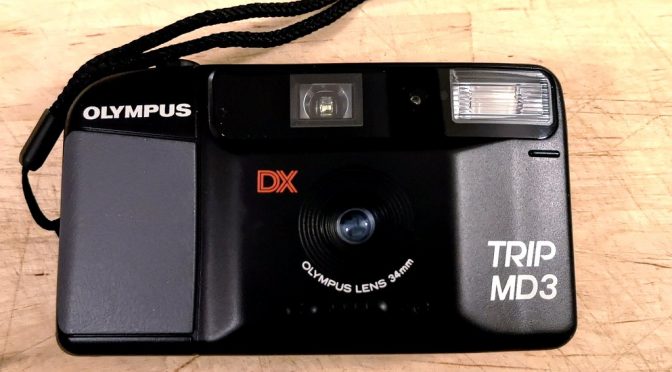
The Raiders of the Olympus Lomo – Part 3 The Olympus Trip MD3
So my quest for the Olympus Lomo continues with another offering from the Plastic Trip series. Could this older model knock off the Trip 505 from the most Lomo like hot seat ?
Is this a lo-fi gem, a pile of junk or an actually okay camera. Grap your whip and Fedora and join us on this journey across erm…. the foot bridge.

Part 1 Trip of Doom
The quest has taken us down the dubious tract of plastic trips before. We’re looking for an olympus camera that has the quirky hallmarks of a camera like the LC-A with colour film. So we want lo-fi but not crap-fi.
And the Plastic Trips hold the key.
Launched in 1984 this long running series pedalled the good name of the legend that is the Olympus Trip 35 even using David Bailey to try and shift em
Funnily enough 35 years later we’d probably want George’s kit !
Trip cameras were divided into 2 groups Auto Focus and more simple fixed focus affairs. We’ve seen a few of the latter already including the likes of the Supertrip (much better than you’d think) and the Trip 500 (just awful).
Part 2 – Driven to Distraction
The MD series of cameras began in the late 1980’s. They herald the arrival of the motor drive in the series (which pretty much ever trip had bar the Supertrip and Trip AF had). Four cameras bear the logo before Olympus realised pretty much ever camera would have motordrive. There’s the Trip AF MD and 3 fixed focus models ingeniously titled MD to MD3.
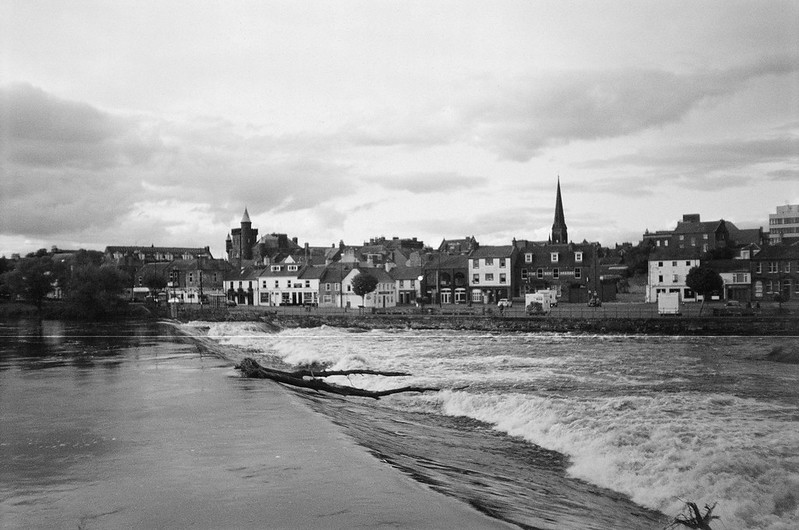
Part 3 Reading the plans
The specs in the manual are pretty standard for the class. We have a fixed focus 3 element 34mm 1:6.9 lens and a fixed shutter of 1/125. The aperture appears fixed as the only exposure consideration the camera appears to make is whether to turn on the flash or not.
Olympus rate the focal range from 1.5m to ∞ but as usually that’s a bit hopeful. If Olympus focused it to the hyperfocal distance of 5 ½ metres you’d get 2.5m to infinity. Irritating the MD3 drops the landscape button on the MD2. This is not great as we’ll see.
There are 3 DX coding pins. These match the S1-3 pins so indeed are really only fit for delineating 100, 200 & 400 ISO films. If you have non DX film it defaults to 100 ISO.

Power is from 2xAA batteries. The flash auto-charges whether you need it or not. There is no way of killing the flash or forcing on. Flash range is meant to be 1.5-2.2m @100 ISO and 1.5-4.4m @400 ISO.
A single Green LED tells you the flash is charged to the side of the simple Reverse Gallilean viewfinder. This does at least have non-parallax frame lines
Part 4 Journey to the QC

The camera is a typical early 90’s plastic lump. Inoffensive is the best I can describe it. The rear of the camera looks like a QD version should exist but I can’t find one.
it’s okay to hold but not as comfortable as some other cameras of the era. Loading is easy with an easyload drop in system (a indicator on the toplate beside the film counter indicates if winding or not.
Simply slide the switch to open the lens cover and unlock the shutter button and shoot. The motor drive is not that refined noise wise and not quick. You will need to manually move a switch on base at the end of roll to rewind.

Although auto, the Flash actually kicks in better than many a more pricey camera. probably as you’re stuck at f/6.9.
Part 5 Shooting Rapids
If you expected tessar quality sharpness you’re reading the wrong blog post mate. We have a simple fixed focus 3 element lens at best in a Cooke Triplet.
The good news is this is actually okay at taking photos at close to median distances. Yup it ain’t sharp but it is okay. The quality falls off to the edges but there is no vignetting.

It doesn’t do shots over 10-20m particularly well and some fringing starts to creep in. There is quite a degree of barrel distortion although you’ll only notice on straight lines.
It overall is better than a disposable even the great Kodak FunSaver.
It actually does well enough with exposure if you don’t push it. the lens is prone to flare and this can be quite unpredictable.
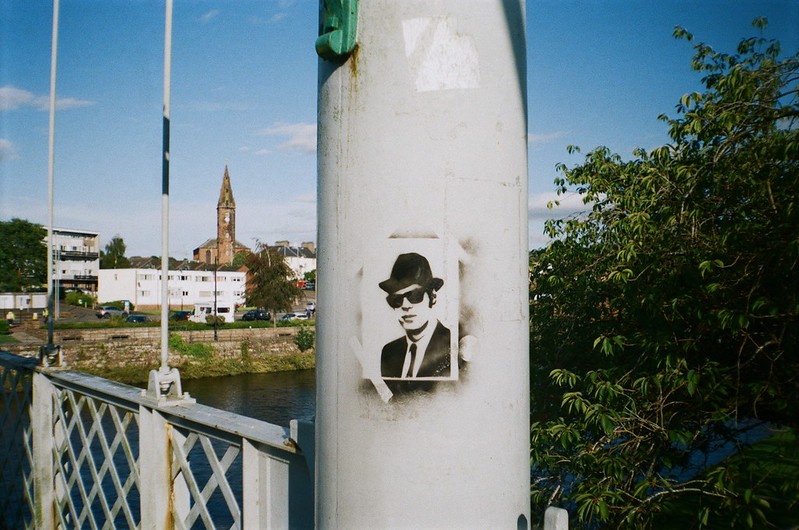
6 Final Thoughts – Not The Road to Lomo
So this an abject failure for the quest for the Olympus Lomo. That’s not because it is bad, in fact it is alight for what it is. And that’s the problem it is far to competent and quirk free
As a camera it is okay in the close the medium distance and with negative film it makes sensible use of the flash for exposure. It is better than a disposable and for a cheap film camera for party shots or trips out you could do worse. Just don’t rely on it for long shots and it is a tad noisy and clumsy.
So I wouldn’t pick one up. The 505 still leads for the moment

Some Alternatives
The more basic Supertrip produces better shots and with a bit of thinking adds some exposure control. Konica POP cameras are a worthy camera in the class and offer a bit more cult appeal. The Ricoh YF-20 is an ugly lump but optically better and like the Supertrip offers the option of exposure control by adjusting ISO. The Hanimex 35SE is also worth a peak in this class but offers some notional exposure control
Share this:
One thought on “the raiders of the olympus lomo – part 3 the olympus trip md3”.
Hope there’ll be more posts about film photography – I’m back into it after 15 years gap.
Leave a Reply Cancel reply
Your email address will not be published. Required fields are marked *
By using this form you agree with the storage and handling of your data by this website. *
Notify me of follow-up comments by email.
Notify me of new posts by email.
This site uses Akismet to reduce spam. Learn how your comment data is processed .
Shooting Film on the cheap on the Border in Credit Crunch Britain
Olympus Trip MD3
The Olympus Trip MD3 is a simple fixed focus 35mm camera Launched by Olympus in 1998. It was the last of the MD series of Olympus Trip Cameras which also featured the Trip MD , Trip MD2 and Trip AF MD . Has Plastic shell. If non DX coded film used defaults to 100 ISO.
Specifications (from manual)
- Fixed focus . Effective 1.5m-∞
- 3 element 34mm 1:6.9 lens.
- Shutter speed fixed at 1/125.
- Automatic flash (1.5-2.2m @10OISO 1.5-4.4m @400ISO)
- DX Coding for 100, 200 & 400 ISO
- Motordriven film advance .
- 2 AA batteries
- Olympus Trip MD3 review at Canny Cameras
- Flickr image
- Japanese 35mm viewfinder
- Image by bigalid
Navigation menu
Personal tools.
- View source
- View history
- List of Companies
- Community portal
- Recent changes
- Random page
- What links here
- Related changes
- Special pages
- Printable version
- Permanent link
- Page information
- This page was last edited on 6 November 2021, at 07:02.
- Text is available under GNU Free Documentation License 1.3 ; other licenses apply to photos.
- Privacy policy
- About Camera-wiki.org
- Disclaimers
Kamera: olympus trip MD3

- 35mm cameras
- Medium format cameras
- Instant cameras
- Single lens reflex cameras
- Rangefinder cameras
- Pocket film cameras
- Disposable cameras
- Underwater cameras
- Medium format films
- Color negative films
- Slide films
- Instant films
- Film sensitivities
- Sample photos
Olympus Trip MD3
- Brand: Olympus
- Name: Olympus Trip MD3
- Predecessor: Olympus Trip MD2
- Type: Snapshot camera
- Type of Film: 35mm
- Focal length: 34 mm
- Maximum aperture: f/6.9
- Focus: Fixed
- Shutter speeds: 1/125 s
- Flash / Flash connection: Built-in flash
- Release date: 1998
- Age: Up to 26 years
The Olympus Trip MD3 is a snapshot camera with many automatic features. It was manufactured by Olympus in China from 1998 to 2002. It is the successor to the Olympus Trip MD2. The “MD” in the name stands for “Motor Drive”. This model does not have much in common with the legendary Olympus Trip 35 .
The camera lens is fixed and not interchangeable. The largest aperture of the lens is f/6.9 with a focal length of 34 mm. There is no possibility to change the focus settings. There is no provision for manual focusing on the subject. To ensure good image quality, you should keep a distance of at least 150 cm from the subject.
The camera has film speed detection. This value is read out via the coding on the film cartridge. However, this value is only used for the flash. The shutter speed is fixed at 1/125 second.
The camera weighs 185 grams. The dimensions are 12.4 x 6.9 x 4.5 cm. The camera requires two AA batteries ( eBay / Amazon * ), which provide the power for all camera functions. A tripod thread is found on the bottom.
Films for the Olympus Trip MD3
The Olympus Trip MD3 is designed for 35mm format and exposes corresponding films. The film transport is motorised. After each picture, the film is transported further. Through a window on the back you can see the inserted film. There is a frame counter on the top.
The 35mm format is one of the most widely used film formats and for this reason there are still some suppliers and manufacturers who produce and sell material for this format.
Available photo films for the Olympus Trip MD3, which are straightforward to get from online retailers, are the Kodak T-Max 400 * for magical black and white photos and the Kodak Gold 200 * for brilliant colour images.
Value of the camera
The Trip MD3 is certainly not one of Olympus’ top models. With some of the Japanese cameras, you still have to put a three-digit amount on the table today. For a used copy of the Trip MD3, you currently pay an average of 45,44 Euro.
Technical datasheet
Write a comment antworten abbrechen.
Deine E-Mail-Adresse wird nicht veröffentlicht. Erforderliche Felder sind mit * markiert
Mit der Nutzung dieses Formulars erklärst du dich mit der Speicherung und Verarbeitung deiner Daten durch diese Website einverstanden. *

- 35mm Lenses
- Camera Reviews
- Point and Shoot
Olympus Trip 35 – Camera Review
Josh solomon.
- October 3, 2016

As enthralling as photography can be, long days, months, and years spent shooting can wear you out. In the worst case, it can lead to a photographic malaise that can dismantle even the most well-built minds from the inside out. It can render the best shooters incapable of even the simple task of pressing a shutter button. It’s shooter’s block, our equivalent to writer’s block, and it hit me hard over the summer.
I jumped out of bed one morning full of energy, ready to take on the world with my trusty Nikon F and Leica M2. But instead of plunging into a world filled with beauty, intrigue, and possibility, I found my surroundings cold, ugly, and indifferent. The images I tried to form seemed trite and overplayed, and I soon lost confidence in my ability to make a decent picture. Even the storied reputations of my F and M2 failed to inspire me. Every time I peered through their viewfinders I saw nothing but dust in the pentaprism and emptiness between the framelines.
Sufficiently depressed, I decided to stay home and put my cameras on the shelf. And it was while I was lying face down on a pillow listening to the opening lines of Chicago’s “Hard To Say I’m Sorry” that I realized I did, in fact, need a little time away. But I didn’t need a full-on vacation from the hobby itself – no, that would be too drastic. I just needed a change from the manual cameras that sat on my shelf. I needed an easier camera, and I had a feeling one camera in particular could fit the bill – the Olympus Trip 35.

The Olympus Trip 35 is a camera I’d heard a lot about but had never tried myself. Its reputation for ease of use and high quality seemed the perfect cure for my shooter’s block. And if the Trip 35 was the prescription, the Pasadena Camera Show was the pharmacy. There I found a beautiful Trip 35 for an absurdly low price, bought it, and quickly threw it in my bag.
One would think the Olympus Trip 35 would seem out of place next to legendary cameras like the aforementioned Nikon and Leica, but it actually fits right in. This camera, although not as capable as the other two, holds an equally lofty place in photographic history. Just as the F and the M defined the SLR and rangefinder genres respectively, the Trip 35 defined the point-and-shoot game. More impressive still, the Trip 35 actually outsold the Nikon F and the Leica M2 by millions. Take that, fanboys.
Olympus achieved these massive numbers by appealing to the casual shooter rather than pro photographers, specifically focusing on the new generation of moneyed vacationers. Racing from landmark to landmark and airport to airport, these sightseers simply lacked the time and interest needed to learn the boring particulars of photography required to operate a camera. Instead, they required a camera that was simple to use, but sophisticated enough to beautifully capture their memories.
Good design marries aesthetics to functionality, and the the camera gods couldn’t have picked a better company to bring the Trip 35 to life. Olympus’ design house, fresh off the ingenious half-frame Pen F, struck gold again with the Trip. The design is classic Olympus; clean-cut lines and an impossibly small form factor, the Trip wastes no time and gets straight to the point. It’s as well designed as any machine of its day, more impactful when we recall that the Trip came of age in an era where cameras were still fully mechanical, save for the occasional battery powered light meter. Automation seemed a distant (and expensive) fantasy, so when Olympus created a genuine auto-exposure camera out of primitive nuts and bolts, the world took notice. This was in no uncertain terms an engineering miracle.
The Trip 35 accomplishes this sorcery by determining the amount of light that enters a Selenium photo cell surrounding the lens, and choosing a correct aperture based on this reading. The camera then chooses a shutter speed of either a 1/200th or 1/40th of a second and we get a perfect exposure. When the camera’s incapable of making an acceptable exposure, a little red flag shows up in the viewfinder and the shutter locks out. The magic of this system is that it takes all exposure-related worry out of our minds. We don’t have to agonize about aperture, shutter speed, or even battery life, a godsend for vacationers and anxious photo geeks.
But before we experience it, it’s quite easy to question the Trip 35’s simplicity. After all, how accurate could a camera this old and primitive be? And could the lens be good enough for our 21st century eyes? As I drove home from the camera show, my new Trip in the passenger seat next to me, these questions rolled through my mind. I really needed this camera to be decent, if I was to pull out of my photographic death spiral.
Just then, I received a text message from my sister. Can you pick up some pork buns in chinatown? thx. With this, I had my mission; buy some pork buns, shoot the Trip, and see if this ancient camera could walk the walk.
The first thing I noticed was its build quality. Comprised of metal and plastic, the Trip 35 is solid, but never heavy; lightweight, but never flimsy. The only disappointing aspect of the camera’s feel is its film advance wheel. A dinky plastic affair reminiscent of disposable cameras, this lackluster cog is forgivable when we remember that the Trip was built to be a consumer-level camera.
Peering through the viewfinder showed bright frame-lines with tick marks both for up-close shots and for landscape shots. These are helpful in view of the Trip’s lack of automatic parallax correction. Having used fancy Leica , Nikon , and Contax rangefinders renowned for brightness and clarity, the Trip’s viewfinder beats most of them. Its relative simplicity is a nice change from the cluttered and overly complex viewfinders of other machines. The Trip 35 also features a small window in the bottom right of the VF (affectionately dubbed the “Judas Window” by Trip 35 disciples) which shows both the chosen aperture and exposure setting on the camera.

So far, so good. But how was I to determine focus? I quickly realized that the Trip’s a scale-focus camera, which is not ideal for accuracy. But before I started feeling like Olympus left me all alone and helpless, I realized that they were kind enough to provide some handy distance-measuring tools. Settings along the lens barrel show a picture of one person for portraits, two people for pictures of two people, three people for group pictures, and a mountain symbol for everything in the distance, including mountains. I stopped hyperventilating, and realized that, for a point-and-shoot camera, this is more than enough. And for all you nitpickers, Olympus also included precise distance measurements in both meters and feet on the underside of the lens. Phew.
Once shooting the Trip started to shine, and I was easily able to focus on exactly what matters most in photography – composition. From the first frame I found myself joyfully snapping away at whatever tickled my fancy, even though I didn’t know what aperture values and shutter speeds the Trip 35 was choosing. Frankly, I didn’t give a damn. All that mattered to me was finding different angles, new ways to play with light, and how to capture Chinatown’s unique charm. It felt like with each and every frame, the Trip was dissolving my shooter’s block more and more, and I wanted to just keep shooting.
So the little Olympus and I danced through Chinatown’s colorful landscape, happily snapping away. In no uncertain terms, it was the most fun I’d ever had with a camera. Even though the heat of the afternoon beat on my shoulders and the sweat sizzled on my brow, the Trip 35 and I ran through the city without a care in the world. The streets led us to the door of a steamy Chinese restaurant, then a pile of steaming pork buns, then back to the equally steamy interior of my car. I didn’t care how long the journey took or how much fluid I lost in that heatwave. It seemed like I sweated out my shooter’s block, and I eagerly raced home to deliver the buns, and develop the film.
But something was nagging me about the camera the entire way home; the focus issue. Had I gotten the focus correct for every shot? How was I to trust those markings? How could I possibly live without a focusing aid? Anxiety began to rear its head again and I had to stop myself from speeding over to a one-hour photo lab to assuage my fears. I gripped the steering wheel tight and told myself to trust the Trip. Besides, I still had a job to do. These pork buns weren’t going to deliver themselves.
After delivering and munching on said pork buns with my contented sibling, I decided to get the roll developed and scanned. My fears were partially founded. Some of the shots, especially photos of close subjects or darker scenes, came back fuzzy due to a combination of my poor distance estimation and the nature of the Trip’s exposure and focus systems. While the Trip automatically helps achieve sharp focus by selecting a smaller aperture for greater depth-of-field, this is only possible in bright light. As things get dark, the ability to shoot at a smaller aperture quickly disappears. In these situations it can be really difficult to nail correct focus. One minor consequence of this is that shooters with an affinity for portraiture and those sweet bokeh balls will probably be disappointed by this camera.

But expecting creamy bokeh and close range performance from the Trip 35 (or most point-and-shoots for that matter) is like expecting a ‘93 Honda Civic to outpace a Tesla Model S. It just won’t happen, and trying will lead to frustration. But just like that Honda, if you regard the Trip 35 as a reliable machine good for an occasional joyride, it will never disappoint. The Trip 35 is capable of a great many things , but we must be careful to recognize and respect its own limits.
When we get the focus right, the Trip’s fantastic 40mm F/2.8 Zuiko lens delivers in spades. The lens is a front-focusing Tessar type lens, which means that it’s very simple and very sharp, and it retains this sharpness edge to edge without chromatic aberration, spherical aberration, or any kind of distortion due to its simple optical formula and Olympus’s masterful execution. The lens’ quality even overcame the limitations of expired film, and ended up giving me some great results.
For whom is this camera best suited? First and foremost, the Trip 35 might just be the perfect camera for the casual photophile. Olympus built this camera to document the daily adventures of the everyman, and the Trip does this beautifully. And for experienced shooters, the Trip 35 can be a great way to break free of shooter’s block, or inject our shooting with something fun and carefree. It emphasizes the art of composition rather than the cold calculations of exposure, but even more importantly, it reminds us to relax, have a pork bun, and not take ourselves too seriously.
Want to try the Trip 35 for yourself?
Buy it on ebay, buy it on amazon, shop b&h photo’s vintage gear, follow casual photophile on facebook and instagram.
[ Some of the links in this article will direct users to our affiliates at B&H Photo , Amazon , and eBay . By purchasing anything using these links, Casual Photophile may receive a small commission at no additional charge to you. This helps Casual Photophile produce the content we produce. Many thanks for your support. ]
Share this post!
- Click to share on Facebook (Opens in new window)
- Click to share on Twitter (Opens in new window)
- Click to share on Reddit (Opens in new window)
- Click to share on Pinterest (Opens in new window)
- Click to share on Tumblr (Opens in new window)
- Click to email a link to a friend (Opens in new window)
- Camera Review
- film camera
- olympus Trip

Josh Solomon is a freelance writer and touring bassist living in Los Angeles. He has an affinity for all things analog. When not onstage, you can find him roaming around Southern California shooting film and humming a tune.
29 comments
Very nicely done.
Great review of the Trip! This is the camera that lured me away from Lomography and the whole low-fi aesthetic. While the metering system is somewhat primitive and the zone focusing can be imprecise, especially in low light, it’s obvious that all the money and work went into the lens. In the right circumstances it’s absolutely tack sharp. Once I started getting sharp images from my Trip, the Lomo LC-A+ and the Holga started looking a lot less appealing.
The Trip definitely has some big limitations but on its own terms it’s a great camera.
Here’s my Trip album on Flickr to get an idea.
https://www.flickr.com/photos/21156896@N07/sets/72157645739914959

Thanks for adding your Flickr album. It’s great for people to be able to see what these cameras can do in varied situations.
Thanks so much! Those images are fantastic; they really showcase what that lens can do. Funny you mention the LC-A+… ?
Thanks! The LC-A+ was the camera that got me back into using film after an extended dalliance with digital photography. I used it really heavily for about 2 years before becoming curious about other cameras. The fact that the Lomo is also a zone focuser made it very easy for me to switch to the Trip and the XA2.
Great write up Josh, and really nice album Neilson! I had to do a double take on some of those shots, especially the close up portraits, realizing that you had used a Trip.
I agree, what a great review and some fine shots on that flickr gallery. I’ve just bought my 50th Olympus Trip 35 and am steadily rebuilding them from head to toe. I’ve posted some reviews and other helpful reviews on my site https://trip35.co/
Great pictures from the Trip. You got to love these little cameras!
The Trip 35 was *made* for landscapes and group photos in good light outside. It’s really dang good for those things. For everything else, not so much! But like you, on a day when I’m just out and about shooting stuff, I find the Trip 35 to be big fun.
My last outing with my Trip 35: https://blog.jimgrey.net/2015/04/20/olympus-trip-35-revisited/
If I ever get on an airplane again I think I’ll be bringing this camera… We’ll see. Josh and your post have helped convince me. Thanks for sharing.
Great review of one of my favourite cameras and one of the best free cameras I’ve ever been given. The quality you can get from this little package has always astounded me, this is an example taken with just bog standard Poundland special film (Agfa Vista 200) https://the6millionpman.wordpress.com/2016/09/30/cardiff-bay-sunset-3/
And yet again I confess to being an Olympus fanboy.
Beautiful colors and range on that.
Great article Josh, and thanks for publishing it James. There wasn’t a link, but I started the Olympus Trip 35 users group on Facebook, here is the link. P.S. A few famous photogrpaphers in the group.
http://www.facebook.com/groups/OlympusTrip35
Hey my friend! Thanks for commenting. We did include a link there, it’s in the third to last paragraph where it says the Trip is “capable…” etc.
And for anyone down here in the comments, do check out the FB group. Amazing talent there shooting with all kinds of Trips.
The Trip Flickr group is worth checking out too. Lots of good stuff there.
https://flic.kr/g/5jsssh
Great write-up! I have three of these and, while I’m by no means a great photographer, I do love the pick-up-and-go nature of the Trip 35. For those who are interested, I spent an entire day refocusing the lens on one of mine;
https://teeritz.blogspot.com.au/2014/04/re-focusing-lens-on-olympus-trip.html
Almost drove me nuts!
That post is scary. You’re a brave man.
Bought a Trip after reading a recommendation by Ken Rockwell. At the time I thought I only ever needed one camera – an FE – and I had one. However, the Trip is great for other things. As you say, the pictures are so sharp. And its so easy to use.
I love my Trip 35. Fantastically sharp lens and incredibly easy to use! The zone focusing took a bit getting used to and I do still occasionally misfocus, but when that happens I embrace my inner William Klein. Also, my copy came with a lens cap and zipped up in a bag so the selenium is not at all worn out and the AE is spot-on. I actually trust shooting slide film in this camera more than any of my all-manual cameras!
Hi! Thank you so much. I am seriously considering to buy a Trip. I want to go traveling and bring a good camera. Do you think this one will do? And some people say it’s not really for taking photo’s in the dark/on parties. Are they right?
Thanks again 🙂
Hey Nikki! The Trip is the perfect camera for travel and casual outdoor shooting IMO, but it does suffer in low light without a flash. A little compact flash will help, and it does have a manual aperture override for accurate flash exposures.
If you’re going to be spending lots of time indoors I would suggest either picking up a cheap P&S with a built in flash, or upgrading entirely to a compact SLR/fixed-lens rangefinder with a fast (f/2 and under) lens for low-light shooting without a flash. Hope this helps!
Hello Nikki, I am the Admin of the Olympus Trips 35 Users Group, I recommend you join to get advice, and there are trustworthy sellers in the group.
See the website link below my comment
I’ve recently picked up aTrip 35 and have been very pleasantly surprised by the ease of use and picture quality. I even tried some low light close shots and had better results than I expected. Tip #1: use 400 speed film to increase versatility. You get more depth of field in any situation and therefore more focussing accuracy. You will also hold off the “red flag” for a stop or two. Tip #2: learn how to guesstimate the zone distances as accurately as possible. If you’re shooting close-up in lower light try to nail the actual distance e.g. set the lens on 1 meter and try to be 1 meter away. Use a tape measure at first so you can see what the distances look like. As the light falls or distances get closer then more accuracy is required from the photographer. Tip #3: remember that you can press the shutter button half way down to lock the exposure. Meter off a mid-tone then recompose and shoot. This will help with back lighting and other tricky light. Tip #4: try to shoot within the limits of the design and you will get good results. The Trip 35 was meant for family holidays and a whimsical approach to photography. If you require critical focussing or metering the Trip was never really designed for that. Enjoy!

Hi, Josh. Great writing. I enjoyed reading your review and laughed so much at the pork bun adventure! Thanks!
Thirty-seven years of shooting film and the Trip 35 was a camera I’d always ignored for being ‘too simple’. I spotted one in a local charity shop last week that was cased, boxed and in lovely condition and I got it for next to nothing. I ran half a roll of FT-12 ASA50 cinema film through and the results were far better than I expected. I started out on Olympus all those years ago (still use them) but I’m a bit ashamed of myself for ignoring this little gem. My 8 year old is just starting to take an interest in photography and this is going to be ideal for her.
Thanks for a great review and for pointing out a couple of little features I hadn’t spotted.
Quick pedantic note: In virtually everything I’ve seen online about the Trip 35, there’s one thing that nobody ever seems to say:
The Trip 35 is essentially the full-frame version of the earlier half-frame Pen EES and EES-2.
I had an EES-2 and it was a great shooter for an inexpensive camera. It worked exactly the same way as the Trip: the selenium meter around the lens chose one of two shutter speeds or raised a red flag if there wasn’t sufficient light; it had a four-icon zone focus lens; there was one manual speed for flash along with adjustable f-stops when not in Auto. Of course, the Trip had a different focal length lens to produce a full-frame image, but I suspect it’s of a very similar design to the EES-2’s. And note that the Trip 35’s top plate includes the EES-2’s hot shoe, along with the back cover/rewind knob from the Pen series (and frame counter from the Pen F series), and the viewfinder is essentially the same as the EES-2’s.
My point is: the Trip 35’s super-successful design wasn’t actually new, the camera was scaled up from the already successful Pen EES series.
Thank you… Now I’m on my way for fun an Mindfulness 🙂 A very brilliant text who give me interests and energy. Thank you 🙂
Just bought one, trying it out tomorrow. I would suggest to buy a tripod and a self-release cord, set it to A and just set for the distance. I used to carry a 110 film camera back in 1977 and was taught photography back in 1981 from a WW2 vet. Warhol used a Pentax 35afm because he could set a high iso without flash.
Leave a Reply Cancel reply
New york city and the half-frame 35mm olympus pen d, the cinematic point and shoot – minolta p’s (freedom vista) review, olympus xa2 – point and shoot 35mm film camera review.


How To Use The Olympus Trip
April 28, 2023 By Cameras By Max
The Olympus Trip is a super popular camera among beginners to film, so here is our guide on how to use this awesome little camera, and some tips on how to get the most out of your Olympus Trip.
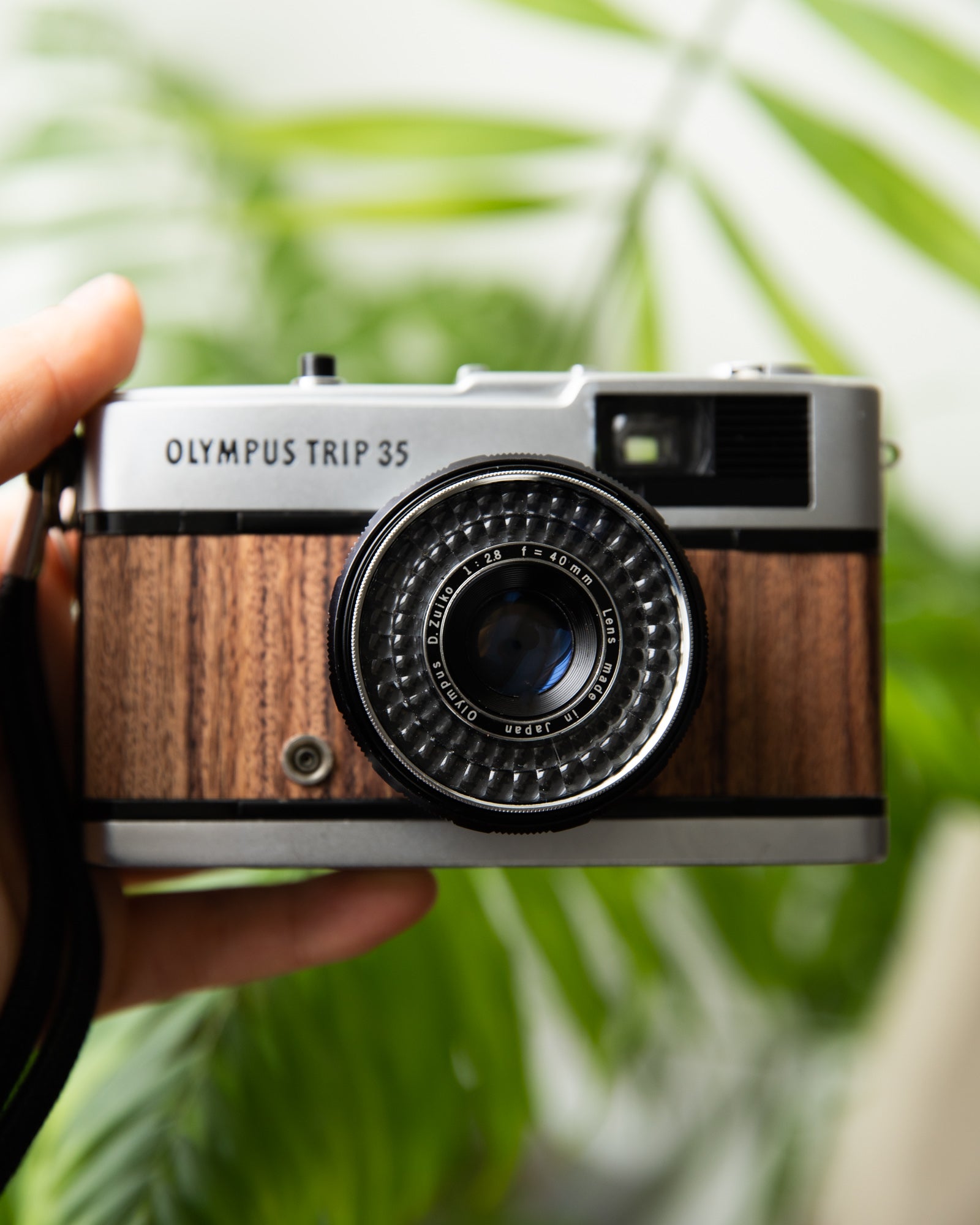
What is the Olympus Trip?
The Olympus Trip 35 was introduced in 1967, and discontinued in 1984, which is considered a long production run for a 35mm film camera. Over ten million Olympus Trip cameras were sold in this time.
Many people wrongly call the Olympus Trip a rangefinder camera, however we would classify it more as a point and shoot with zone focusing.
What features does the Olympus Trip have?
The Olympus Trip is really easy to use, and has some cool features that set it apart from other point and shoot 35mm film cameras.
- Zuiko coated 40mm f/2.8 lens : this lens is sharp, and the wide aperture makes it versatile in a lot of situations.
- Automatic settings : the Olympus Trip has two shutter speeds and aperture from f/2.8 to f/22.
- No batteries needed : the Olympus Trip is powered by the selenium meter around the lens. This is also what receives light and tells the camera which aperture is needed.
- Red flag feature : when the camera does not have enough light to take a photograph, a red flag appears in the viewfinder.
- Zone focusing : the Olympus Trip has four focus settings depending on how far away your subject is from the camera.
What are the different parts of the Olympus Trip?
The top plate.
The Olympus Trip top plate is very simple. The camera features are easy to find, making it an ideal camera for beginners. Below is a labelled diagram of the camera.
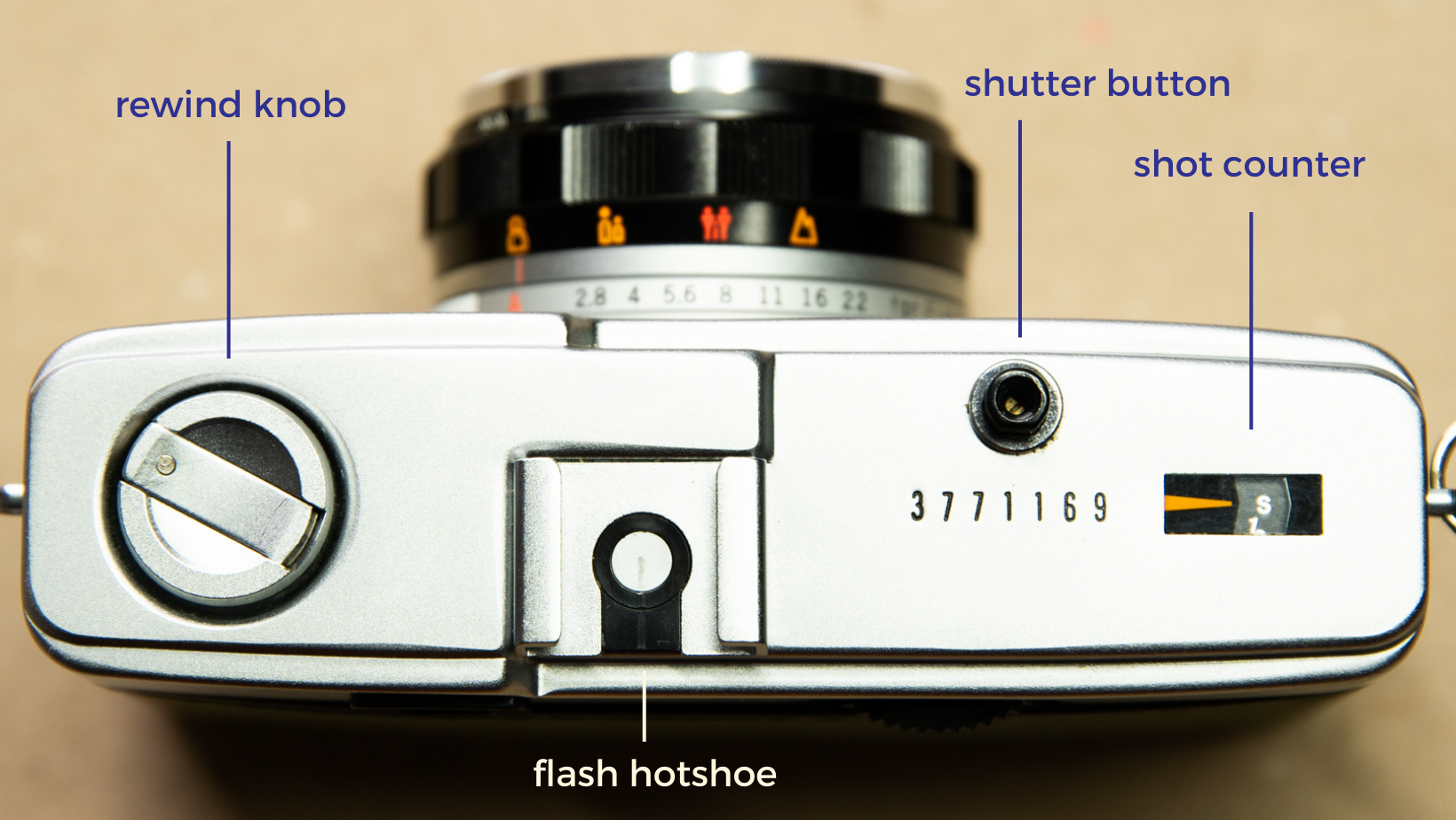
On the left of the top plate is the rewind knob (more on that later). In the middle is the flash hotshoe, used for mounting hotshoe flashes to the camera. The shutter button is the small black button on the top. On some models of Olympus Trip, this button can be silver. The small panel on the right is the shot counter that displays the number of shots you have taken.
The Olympus Trip lens holds most of the key settings for the camera , such as the ASA, focus, and aperture.

The ASA dial is set to match the roll of film that you put in the camera. For example, if you are using Portra 400, the ASA setting is set to 400.
The focus settings are simple, and known as zone focusing. There are four zones to choose from. We go through them in more depth later on in this article.
The aperture settings are only used if you are using flash. Otherwise, the camera is set to "A", which allows the camera to choose the aperture and shutter speed automatically.
The Bottom Plate
There is only one function on the bottom plate of the Olympus Trip 35: the rewind button. (And the tripod mount, technically.)

The rewind button is pressed when you are ready to start rewinding your film.
How To Load Film In The Olympus Trip
Loading film takes some practice, but it is really easy when you get to grips with it.
To load a roll of film in the Olympus Trip, first you have to open the back of the camera. To open the back of the camera, pull down this small silver tab, shown below.
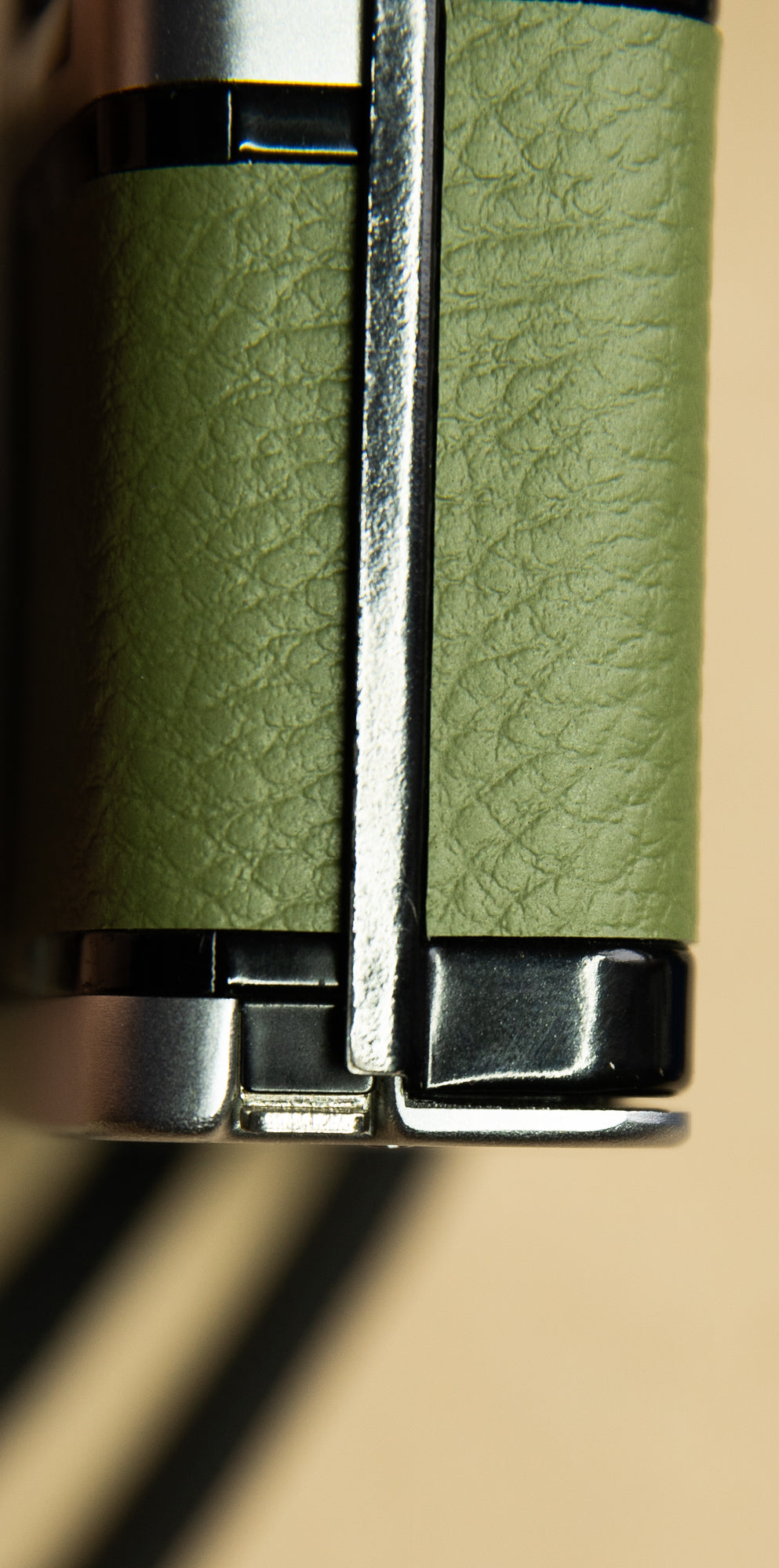
Once you have the back of the camera open, you can load your roll of film. To load the roll of film, pull the rewind knob up. The roll of film goes in with the top of the canister (the part that sticks out) at the bottom of the camera. See the image below.
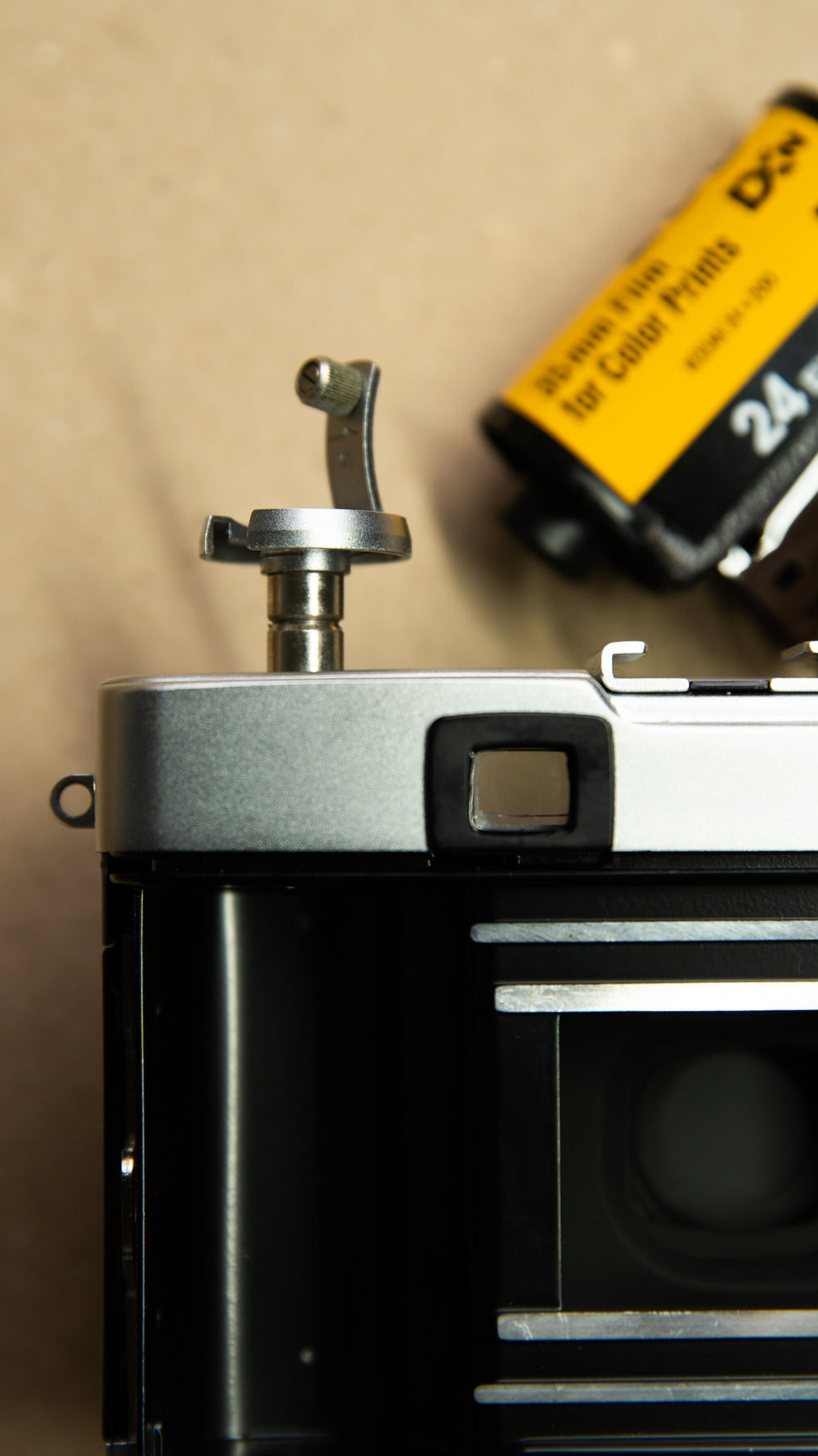
When the canister is in, as shown above, you can pull the film leader across the camera to reach the other side.
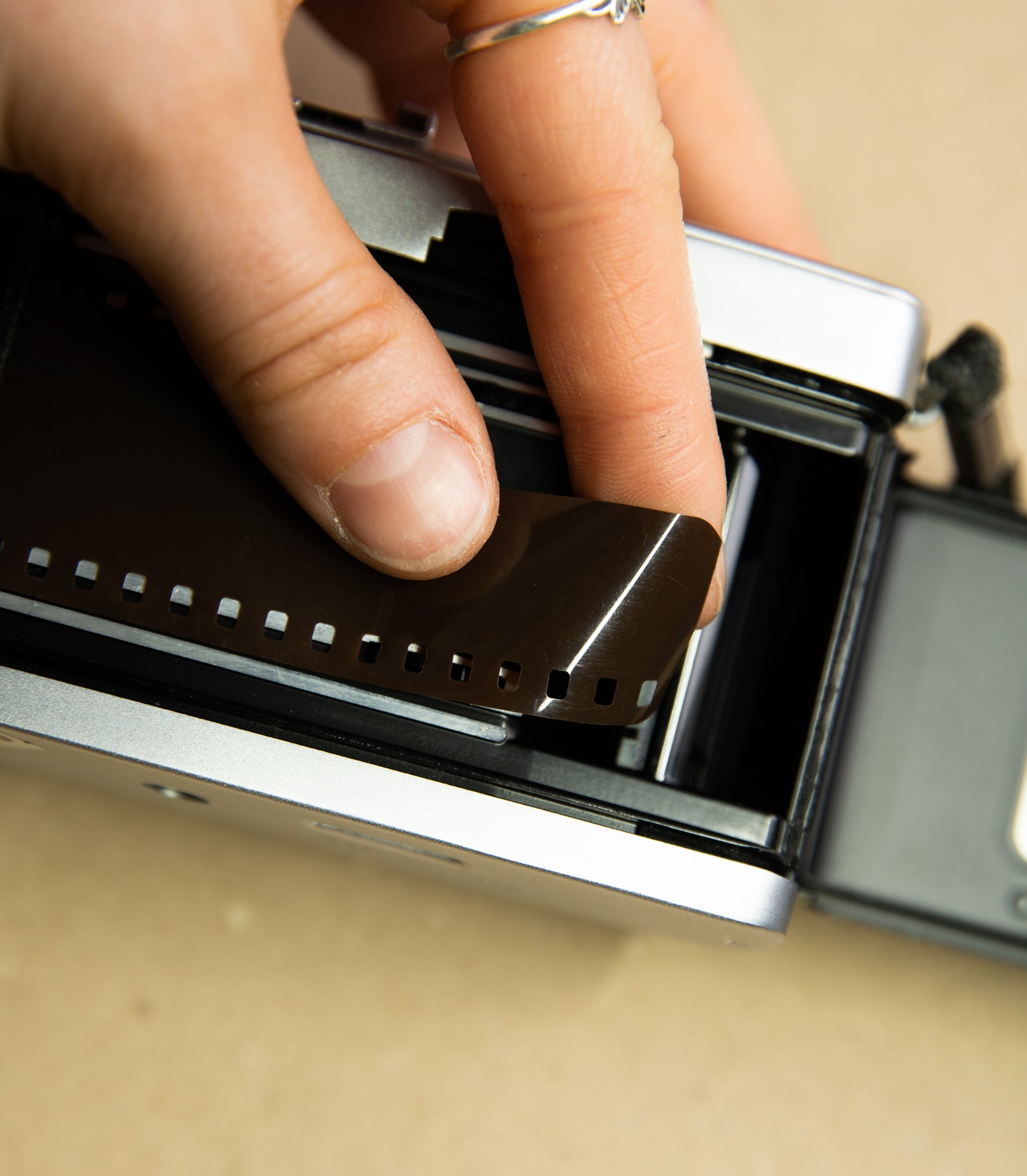
The rewind knob being put back down will lock the canister in place as you pull the film across. In order to lock the film onto the film spool in the camera, it has to go partly into one of the slots, and the notches at the bottom of the spool have to go through the sprockets on the film (the holes).
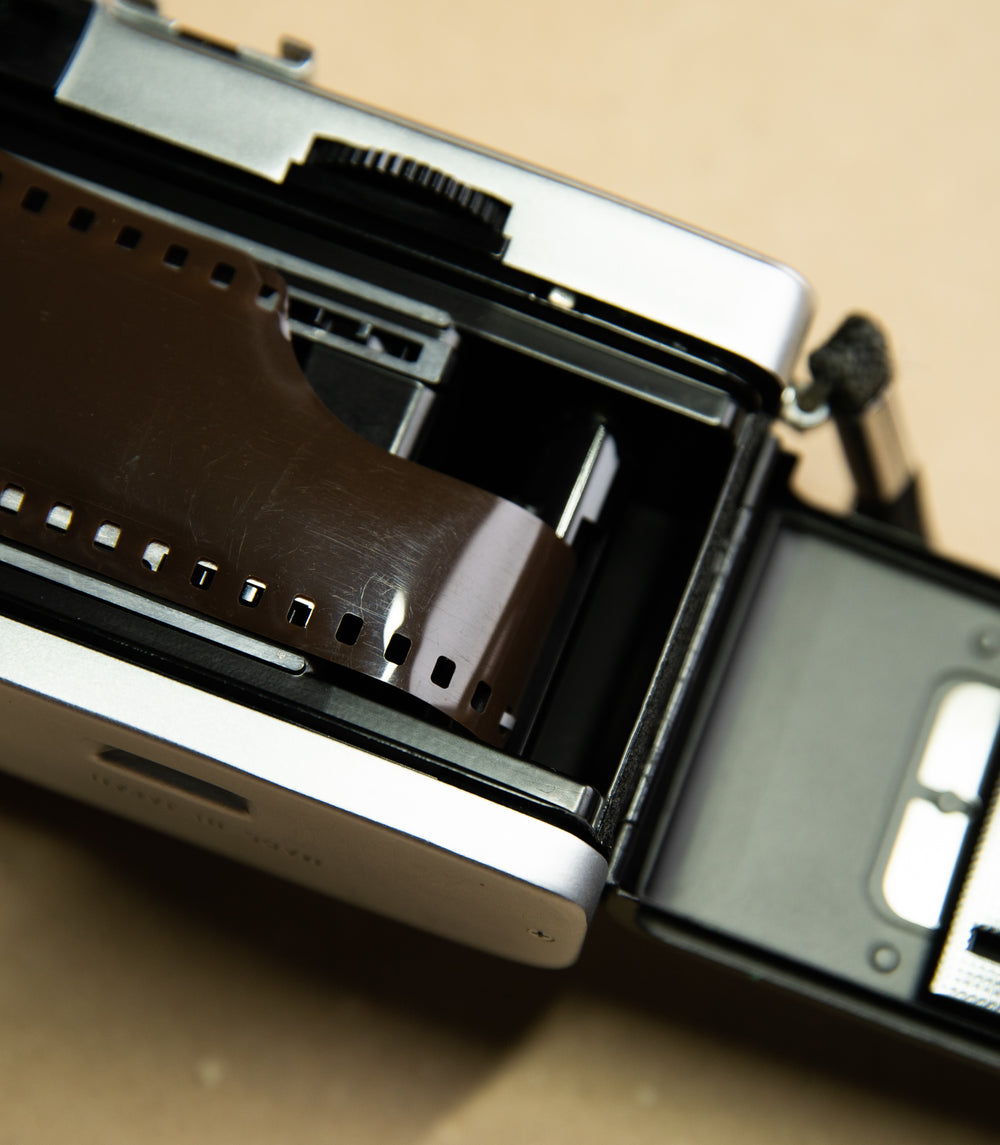
In order to be able to advance the film across the camera, you have to fire the shutter . You can do this by pointing it at a bright light or by setting the aperture setting to one of the numbers.
I recommend firing the shutter, and advancing the film (with the advance thumb wheel) twice before closing the back, so that you can make sure the film is definitely loaded correctly. As you get more confident, you can fire the shutter less times and therefore get more photos on your roll of film.
How To Take Photos With The Olympus Trip
Now you have loaded your roll of film, and closed the back of the camera, you are ready to start taking photos!
The first thing to check is that your ASA is set to the same speed as your roll of film. For example, Portra 400 is ASA 400. Or Kodak Gold is ASA 200.

When looking through the viewfinder, you will be able to see your frame lines, and the focus setting that the camera is set to. The viewfinder of the Olympus Trip does not show you where the focus is set, just which symbol you have the lens set to.
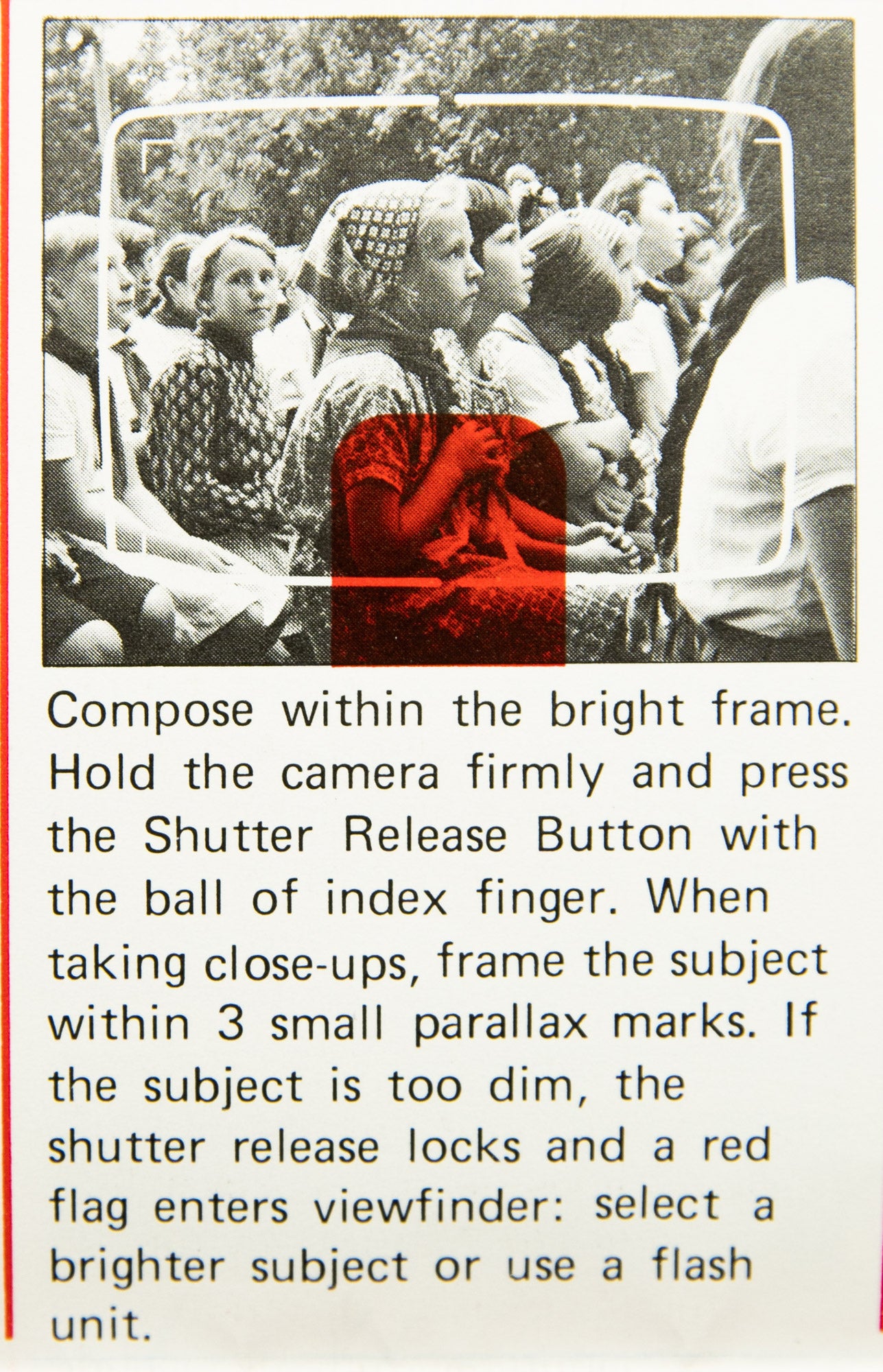
When the lens is set to "A", the camera will choose the shutter speed and aperture for you manually. If the image you are trying to take is too dark, the red flag will come up.
You can override this by setting it to one of the numbers instead, but be aware that these are intended for a flash to be used with it. By setting the Olympus Trip to a number on the lens, it reduces the shutter speed to 1/30 - that's one thirtieth of a second. So you will need to have a steady hand when doing so.
How does the film counter on the Olympus Trip work?
When you first load your roll of film, it may look as though the film counter is not moving. It takes two or three shots for the shot counter to move to the number one.
The back of the camera needs to be closed in order for the shot counter to start working.
The counter shows the amount of images you have taken, not how many you have left.
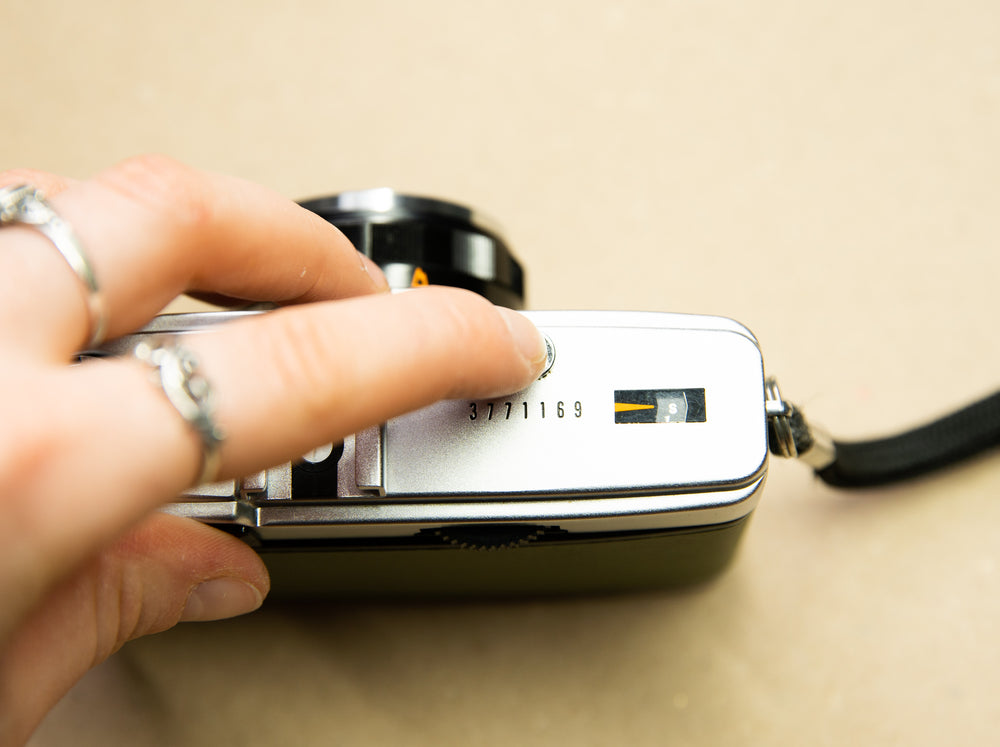
How do I focus the Olympus Trip 35?
The Olympus Trip focus settings are simple, but take some getting used to. There are four settings on the camera. The symbols for these are found on the black part of the lens, as shown earlier in the article.
The symbols are as follows:

The Olympus Trip has four focus settings . The viewfinder view does not change as you change the focus settings, so you need to know which setting is correct for how far away your subject is. Luckily, this is not hard.
The first setting has the symbol of one person. The first setting is used for close-up photographs , where the subject is less than 1 metre away.
The second setting is of two people, which is to be used for subjects from 1.5 to 3 metres away.
The third setting is a symbol of three people. This setting is used for subjects that are between 3 and 6 metres away.
The final setting is a symbol of a mountain, which is used for anything beyond 6 metres away.
If you ever forget these numbers, they are engraved on the underside of the lens (opposite to the symbols on the top).
How does the Olympus Trip 35 red flag feature work?
The purpose of this Olympus Trip feature is to stop you from taking a photograph that is not exposed enough and therefore will not be visible when developed.
When there is not enough light in your image, the red flag will pop up in the viewfinder. You will clearly be able to see it if you are looking through the viewfinder. It also blocks the shutter button from being pressed.
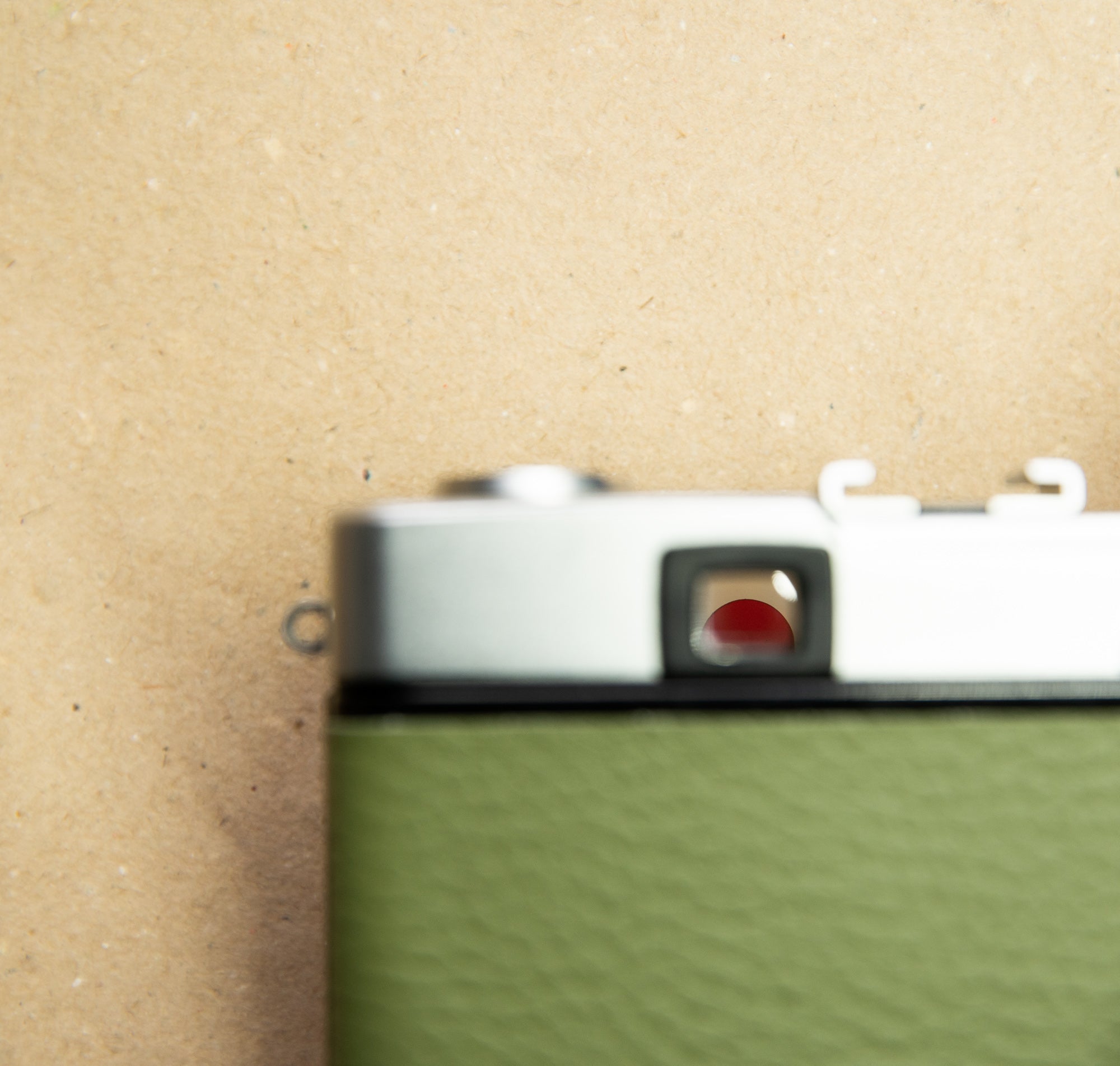
Can I use the Olympus Trip at night?
Yes, you can.
The easiest way to do this is to attach a flash to the top of the camera.
Attaching a flash to the top of the camera is easy and most flashes can be used on the Olympus Trip. It has a standard flash hotshoe on the top of the camera.
Here is an example of a flash that can be used on the Olympus Trip:
When using a flash on the Olympus Trip, there are different settings to use. These are the aperture numbers on the silver barrel of the lens closest to the camera.
The aperture you use needs to be read off of the meter table, which is usually displayed on the back of the flash unit.

You can read more about using the Olympus Trip at night here .
How To Rewind Your Film
Congratulations, you've finished your roll of film.
How can I tell if the roll of film is finished?
You will start to feel some resistance when trying to advance the camera. Do not force it, as you will snap part of the mechanism.
If you are using a 24 exposure roll of film, you will have reached the 24th shot. The shot counter should show the number 24, or near to that number. The same applies for a 36 exposure roll of film, as this will show the number 36. Sometimes you are lucky and get 37 or 38 shots out of a roll of film.
When the film will not advance any more, the film is finished.
How do I take the roll of film out?
On the bottom of the camera is your rewind button. Push this button in. It should stay in after you have pressed it once.
You can now use the rewind knob to rewind the film into the canister. Turn the knob clockwise.

Rewinding the film usually takes around thirty seconds of rewinding. You will feel when the film comes off of the spool at the end, because the rewind knob will have less resistance. Keep rewinding it until you feel certain that the film is back inside the canister.
You can now open the back and take the film out.
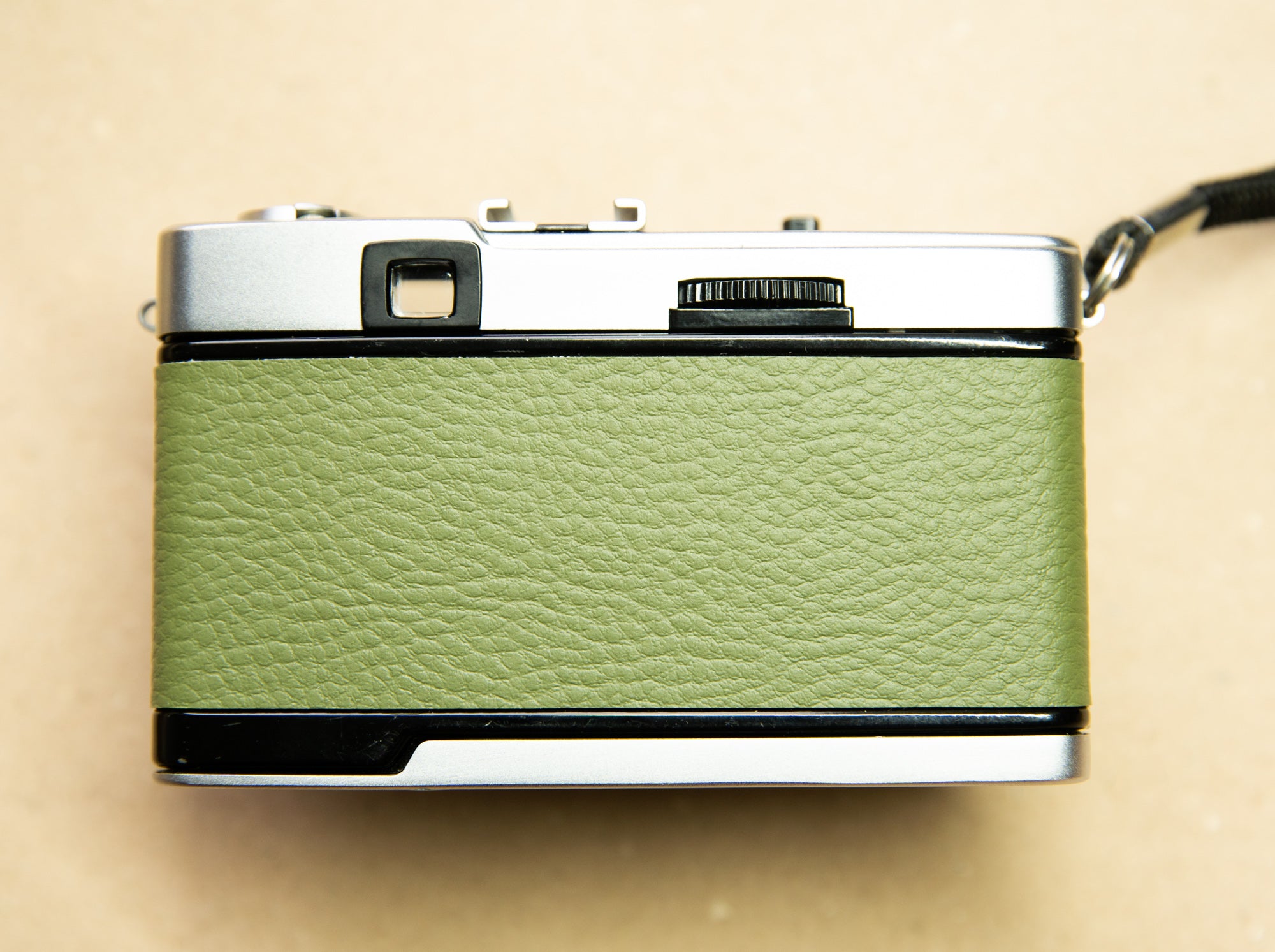
That's just about everything you need to know about the Olympus Trip 35 35mm film camera! We really recommend this camera for beginners, so we hope you have a great time using it and create some lovely images.
I think my Olympus Trip is broken; what should I do?
A lot of Olympus Trip 35mm film cameras have never been serviced in their lifetime. Because they are holiday cameras, a lot of them have sand in the mechanisms.
We highly recommend getting your Olympus Trip serviced if it hasn't been used in a while.
Maintained, these cameras can last many years, however when they have been left for decades, they can develop a few issues, such as stuck aperture blades, stuck shutter, non-functioning light meter, etc.
All of our Olympus Trip services and repairs are very affordable, so definitely consider sending it to us before deciding that it doesn't work, or putting it back in a drawer.
Shop our full range of Olympus Trips and accessories here:
Find out more about the olympus trip here:.

Featured Camera: The Olympus Trip 35

Can You Use the Olympus Trip At Night?
If you like what we do, but can't buy a camera from us, please consider buying us a cup of coffee! It helps us to keep these resources free, consistent, and accessible.

Still stuck on which film camera to buy?
Try our film camera quiz. All you have to do is answer a few questions, and then you will get a list of personalised camera recommendations.
Or send us a message on Instagram , send us an email , chat to us on our live website chat, or read some more of our blog posts!
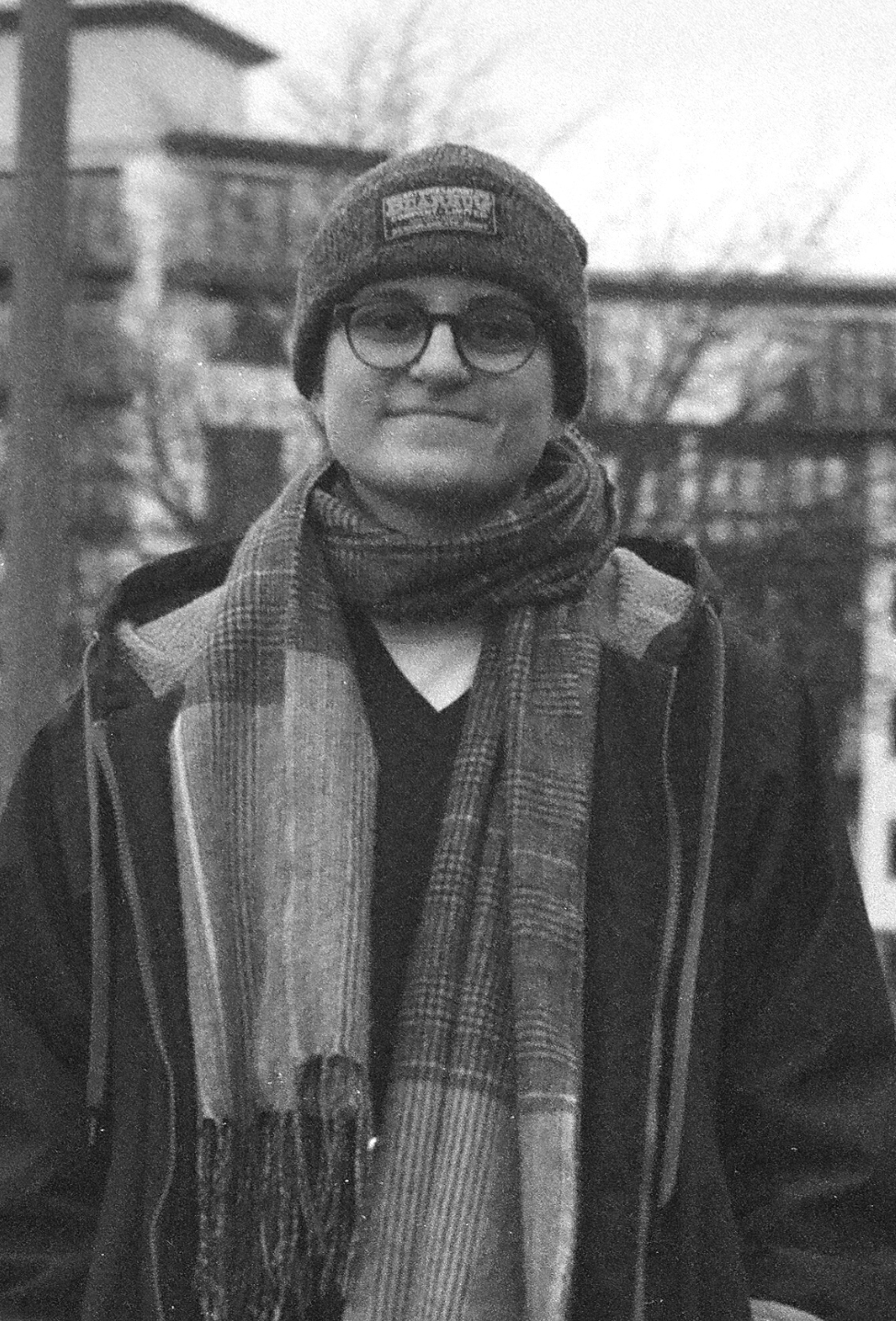
Article written by: Max
Max is the owner of Cameras By Max. They work full-time repairing and refurbishing all the 35mm film cameras you see on the website. Their favourite camera (at the moment) is the Olympus XA, and their favourite city in the world is Edinburgh.
Take our quiz to find your perfect film camera.
Not sure which camera is best for you?
Congratulations! Your order qualifies for a free planted tree. Plant a tree with any order over £60!
No more products available for purchase
Your cart is currently empty.

Point & Shoot Film Cameras | Reviews & news about 35mm compact film cameras & analogue photography
Olympus Trip AF MD, Fully Automatic… more or less
Review of the Olympus Trip AF MD compact point and shoot film camera.
Olympus Trip AF MD technical specifications
The Olympus Trip AF MD has a 35mm, ƒ3.8 lens, a fixed 1/125 shutter speed and a built in flash. That’s pretty much it. It can take DX coded film, but I have been unable to find any information about what the upper, or lower, ISO film speed limits are (I was only able to find a guide for a manual film-wind version of this camera – without the motor-drive). There is no facility to manually set ISO speed.
There is a sliding cover, which protects the lens and also serves as a shutter lock. An auto-wind motor drive forwards the film after each photo is taken and a button, on the base of the camera, will engage the film auto-rewind. On my model, the film rewound, leaving a bit of the film exposed, which is often useful. The Olympus Trip AF MD requires 2x AA batteries to work. An orange light, to the left of the viewfinder, shows when the flash is charged and ready to fire.
Using the Olympus Trip AF MD
The fully automatic aspect of the Olympus Trip AF MD, probably refers to its autofocus lens and motor drive. That said, as best as I can tell, the flash is not auto-focus and has to be enabled manually using a sliding lever, located just underneath the flash itself. Depending on your point of view, this can be a good or bad thing. Personally, I prefer this feature, to point and shoot cameras where the flash automatically engages whether you like it or not – for example the previously reviewed Ricoh FF-7 . Whilst the camera continues to function if you don’t engage the flash – unlike the Yashica Auto Focus , which simply refuses to shoot – a red light appears next to the viewfinder, to indicate if it is too dark.
One useful feature was that, after loading the film, there was a ‘spinning’ red and white bar which indicated that the film was engaged and turning, after each shot was taken. Helping to indicate that a whole series of shots were not being wasted. On the other hand, the film counter itself is tiny and very hard to read.
Related content

Review of the early version Yashica Auto Focus manual wind point and shoot film camera.

User review of the Ricoh FF-7 point and shoot compact film camera. The Ricoh FF-7…

The limitations of cheap, or low-end, point and shoot film compact cameras and film ISO…
- Posted in: Prime Lens Cameras
Posted by P&SFC
VALOI 'easy35' BACK IN STOCK
Item added to your cart
- Film Cameras
- 35mm Film Cameras
- 35mm Film Cameras ›

Kamerastore Digital Database
Olympus Trip MD3 - Camera
Fixed-focus compact camera from Olympus, released in 1998. Otherwise fully electronically-controlled.
- Lens: Olympus 34mm f6.9 (3 elements)
- Shutter: Fixed at 1/125s
- Minimum focus distance: Fixed, range from 1.5m - infinity.
- Size: 125 x 69 x 46mm
- Choosing a selection results in a full page refresh.
- Opens in a new window.
Your wishlist
- Move to cart
My wishlist
Add to wishlist.
Choose your wishlist to be added
- Create New wishlist
Share List Via Email
Or share via, subscribe and get alerts about your wishlist.
We will notify you on events like Low stock, Restock, Price drop or general reminders so that you don’t miss the deal
See Product Details
Are you sure you want to delete this wishlist?
Are you sure you want to delete selected wishlist products, out of stock products will be not move. are you want to move selected wishlist products, wishlist management page.
- This page allows you to manage and add wishlist items directly to the cart.
- Share your public wishlist on social media, through links, and via custom email.
- You can subscribe to get update about your wishlist items
You have been unsubscribed
You will no longer receive emails about wishlist activities from this store..
Checkout using your account
Checkout as a new customer
Creating an account has many benefits:
- See order and shipping status
- Track order history
- Check out faster
Spice up your photography and take stunning pictures with a wide selection of experimental and creative lenses as well as a selection of advanced adapters for your camera.

Ignite the legacy of a fascinating but forgotten scientist, Ibn al-Haytham, and become a master of light with this unique lens designed for spherical aberration control on full-frame mirrorless cameras.

The world’s first photographic optic lens from 1839 – redesigned to work with modern-day digital and analogue cameras and deliver the most unique ethereal aesthetics imaginable.

Use this premium glass lens to achieve ultra-sharp shots with the signature Diana aesthetic.

A reinvention of the original 19th century Joseph Petzval portrait lens. Designed specifically for modern-day full-frame mirrorless cameras.

Enjoy full creative control and endless experimentation with a wide choice of Lomography Art Lenses, experimental lenses and adapters for your analogue and digital cameras.

A reinvention of the original 19th century Joseph Petzval portrait lens for modern-day analogue and digital SLR cameras, optimized for video and boasting an enhanced Bokeh Control Ring for even greater experimentation.

Bring the iconic saturation, vignetting and contrast of the Lomo LC-A to SLR and mirrorless cameras.
Subscribe to our newsletter and get a welcome offer!
Keep up to date with all things Lomography! Subscribe to our newsletter and be the first to know about amazing deals, brand new products, and essential creative photography news.

A lightweight and compact Art Lens System with three interchangeable prime lenses and two aperture mechanisms for unlimited stylistic possibilities.

Shoot stunning photography and videography with full creative control over your shots using your D(SLR) camera and our selection of Lomography Art Lenses.

A reinvention of the original 19th century Joseph Petzval portrait lens. Designed for modern-day analogue and digital SLR cameras and optimized for video.

Embrace a brand new ultra-wide perspective with shots that exaggerate relative size and boast impressive depth for eye-catching, inspiring, immersive photography and film.

This compact Art Lens brings the iconic LC-A characteristics of brilliantly vivid colors and gorgeous vignettes to your M-mount cameras.
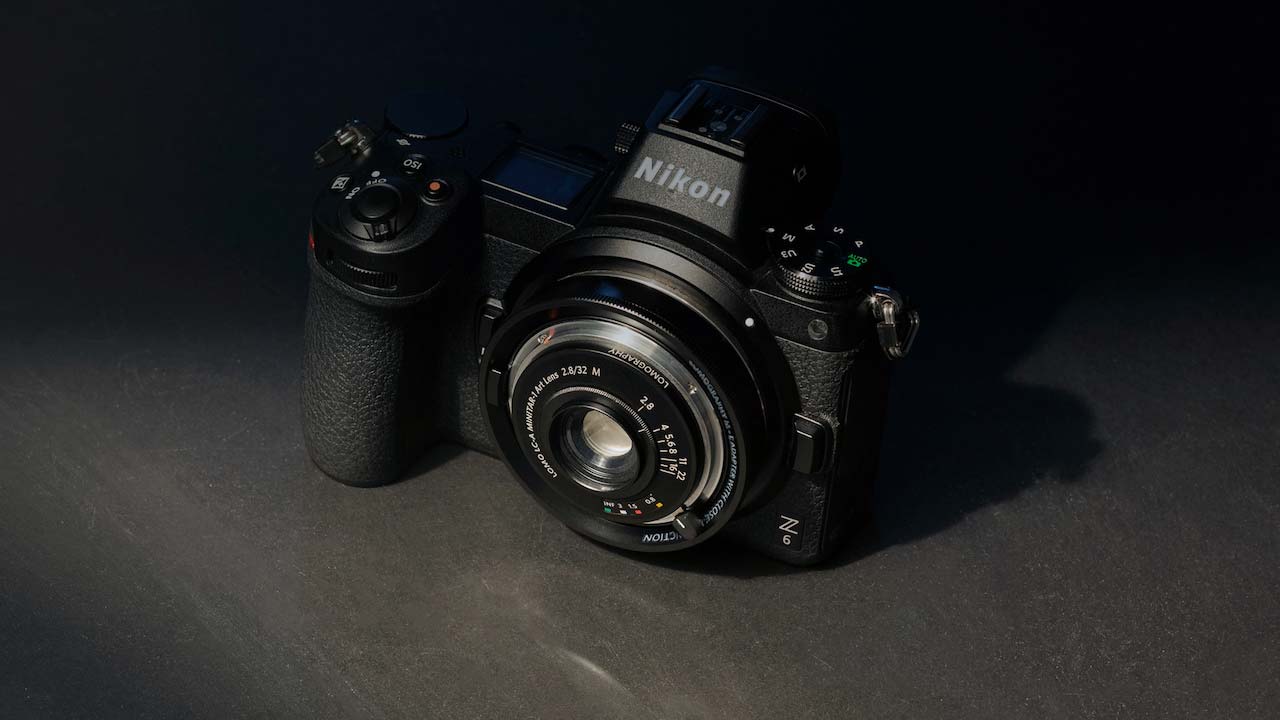
Mirrorless & Rangefinder
Shoot stunning photography and videography with your Mirrorless and Rangefinder cameras and our selection of creative and experimental lenses.

Use your M-mount lenses with your Sony E-mount mirrorless mounts with this compact and lightweight close-up adapter, featuring a built-in lock for precise focusing.

Use your M-mount lenses with your Nikon Z camera with this compact and lightweight close-up adapter, featuring a built-in lock for precise focusing.

Use your M-mount lenses with your mirrorless camera with this compact and lightweight close-up adapter, featuring a built-in lock for precise focusing.

Designed for photographers and filmmakers alike, these elegantly handcrafted lenses celebrate the unique look of Joseph Petzval’s historical lens whilst showcasing fascinating modern features such as bokeh control, dual aperture, coated glass and much more.

Use your Lomography Atoll Ultra-Wide 2.8/17 Art Lens on Sony E mount mirrorless digital cameras with this compact and lightweight close-up adapter, featuring a built-in lock for precise focusing.

Use your Lomography Atoll Ultra-Wide 2.8/17 Art Lens on Nikon Z mirrorless digital cameras with this compact and lightweight close-up adapter, featuring a built-in lock for precise focusing.

Use your Lomography Atoll Ultra-Wide 2.8/17 Art Lens on Canon R mount mirrorless digital cameras with this compact and lightweight close-up adapter, featuring a built-in lock for precise focusing.
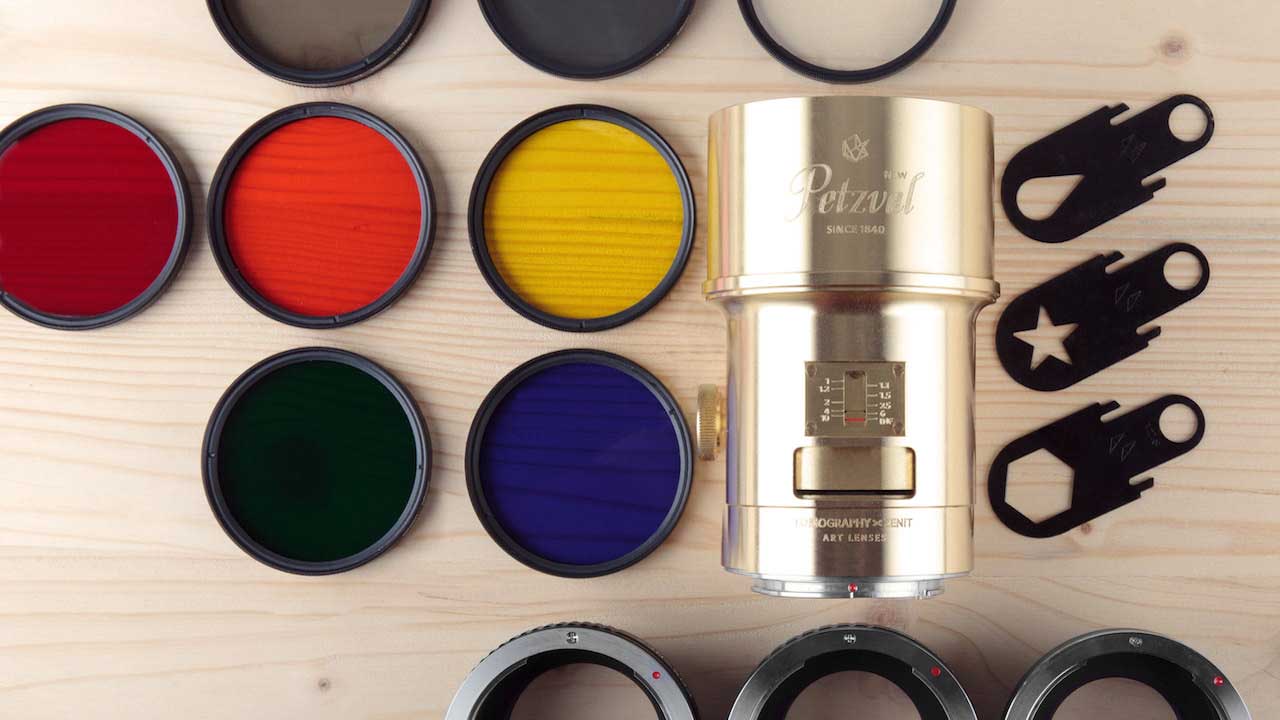
Lens Filter & Adapter
We’ve got a selection of Lens Adapters offering you advanced compatibility for your analogue and digital cameras plus Lens Filters that help you get even more creative with your Art Lens shots.

We and our partners use technologies, such as cookies, to recognize you and show you more of what you like. Please read our Privacy Policy to learn more. By using this website you agree to the use of those technologies.
Shooter Files by f.d. walker
Street Photography Tips, Interaction, Travel, Guides
Apr 24 2017
City Street Guides by f.d. walker: A Street Photography Guide to Moscow, Russia

*A series of guides on shooting Street Photography in cities around the world. Find the best spots to shoot, things to capture, street walks, street tips, safety concerns, and more for cities around the world. I have personally researched, explored and shot Street Photography in every city that I create a guide for. So you can be ready to capture the streets as soon as you step outside with your camera!
At over 12 million people, Moscow is the largest city in Russia and second largest in Europe by population ( Istanbul is #1). An urban, cosmopolitan metropolis with more than enough glitz and glam to cater to the elite, but without losing its fair share of Soviet era roughness around the edges. It can be fast paced, brash, busy, and trendy like other big cities, but it has its blend of West meets Russia atmosphere and beauty that provides plenty of unique interest. The Red Square is as famous as it gets, but there’s so much more to this city, including the most beautiful subway system you’ve ever seen. It would take years to capture all of Moscow, but that means you have an endless amount of areas to discover.

So here’s a Street Photography guide so you can be ready to capture all that Moscow has to offer before you even arrive!
- Patriarch’s Pond
- Old Arbat Street
- Maroseyka Street
- Tverskoy Boulevard
Top 5 Street Spots:
1. red square.
The Red Square is the most famous square in not just Russia, but all of Eastern Europe. The name actually doesn’t come from the color of the bricks or communism, but from the name in Russian, Krásnaya, once meaning “beautiful” before its meaning changed to “red.” This large plaza is what you see on the cover of guide books and magazines for Moscow, with St. Basil’s Cathedral being the center piece next to Lenin’s Mausoleum surrounded by the Kremlin Wall. Of course, the Red Square attracts hordes of tourist due to the main attractions, but all that activity around an interesting atmosphere does provide street photo opportunities. It’s also the central square connecting to the city’s major streets, providing a good starting point to explore outward.

You’ll also find the popular pedestrian only Nikolskaya Street connecting the Red Square to Lubyanka Square. This line of expensive shops includes plenty of activity, while also leading you to another popular square. Filled with history rivaling any city, the Red Square and surrounding areas are the heart and soul of Russia.

2. Patriarch’s Ponds
Patriarch’s Ponds is one of the most exclusive neighborhoods in Moscow. Despite the name being plural, there’s only one large pond, but it’s worth a visit with your camera. It’s a popular spot for locals and expats to come relax or take a stroll around the pond. You get an interesting mix of young and old too, from young love to “babushkas” feeding pigeons. It’s a very peaceful park atmosphere in one of the nicer areas within the city center, while bringing enough activity for street photography.

The pond is shallow and in the winter becomes a popular spot for ice-skating too. The area is also well-known for the location in the famous Russian novel, The Master and Margarita.
3. Old Arbat (Stary Arbat)
Old Arbat is the most famous pedestrian street in Moscow, and dating back to the 15th century, also one of its oldest. Originally, it was an area of trade, but soon became the most prestigious residential area in Moscow. During the 18th century, Arbat started attracting the city’s scholars and artists, including Alexander Pushkin. Cafes lined the streets and impressive homes filled the neighborhood. Since then, New Arbat street was created as a highway in the area, while Old Arbat was paved for a 1km pedestrian only walkway.

Due to the historic buildings, famous artists that lived here, and the bohemian atmosphere, Old Arbat has become a big attraction for tourists today. Now, there’s a mix of cafes, restaurants, souvenir shops, street performers, street merchants and other attractions for visitors, and some locals, to come enjoy. It can get really busy here and there’s usually something interesting going on so it’s a good street to come walk with your camera for guaranteed life.
4. Gorky Park
One of the most famous places in Moscow is Gorky Park. The official name is Maxim Gorky’s Central Park of Culture & Leisure, which gives you an idea of what goes on here. When built, it was the first of its kind in the Soviet Union. Divided into two parts, it stretches along Moscow River. One end contains fair rides, foods stands, tennis courts, a sports club, a lake for boat rides, and more. This end brings more active life due to its number of attractions, while the other end is more relaxed, where you’ll find gardens, trees, older buildings, and an outdoor amphitheater.

Gorky Park attracts mostly locals so it’s a good spot to capture the non-tourist side of Moscow life. Muscovites come here to escape the city and unwind in a picturesque setting. The park remains alive outside of the warmer months too, especially when the lake turns into the city’s largest outdoor skating rink. I’d recommend taking the metro out here to spend at least half a day exploring the massive park’s life with your camera.
5. Maroseyka Street
Maroseyka Street is a popular area not too far from the Red Square. The long, winding street turns into Pokrovka and is lined with restaurants, cafes, bars and places to stay. It’s actually where I like to stay when I’m in Moscow due to its location and solid street photography opportunities itself. You have Kitay-gorod station near and if you keep walking southwest, you’ll get to the Red Square. But if you walk northwest, as it changes to Pokrovka, you can find a long street of activity for photography with its own interesting atmosphere.

6. Tverskoy Boulevard
Tverskoy Boulevard is the oldest and longest boulevard in Moscow, beginning at the end of Nikitsky Boulevard, and finishing at Pushkin Square, a spot to come for activity itself. The boulevard is made up of two avenues, with pedestrian walkways in-between. You’ll find grass, shrubbery, trees, benches and more walking it’s almost kilometer length. Many people come here to enjoy some relaxation, walk their dog, or just to use it to walk wherever they’re going. Its center location also provides a nice place to walk with your camera near plenty of other spots you’ll want to check out anyway.
Sample Street Walk:
For a full day of Street Photography, covering some of the best spots, you can follow this sample street walk for Moscow:
- Start your morning walking around the Red Square (1), while exploring the surrounding area, including Nikolskaya Street
- Then walk northwest to Patriarch’s Ponds (2) and slowly walk the pond and surrounding area with your camera
- Next, walk east to the Pushkin Monument and stroll down Tverskoy Boulevard (6)
- Once Tverskoy Boulevard (6) ends, it will turn into Nikitsky Boulevard. Follow this down until you get to the start of Old Arbat Street (3), across from Arbatskaya station
- After you’re done walking down Old Arbat Street (3) for more street photography, spend some time checking out Moscow’s beautiful metro stations
- To finish off the day with more street photography, get off the metro near Red Square (1) again, Maroseyka Street (5) or wherever you’re staying for the night.

3 Things I’ll Remember about Shooting in Moscow:
1. museum metro.
The Moscow metro system was the first underground railway system in the Soviet Union and today includes 203 stations across 340km of routes. The elaborate system has some of the deepest stations in the world too, with escalators that seem to go on forever. None of this is what makes it so special, though. Many of its stations feel like stepping inside a museum, making it without a doubt the most interesting and beautiful metro system I’ve been in.

When built, Stalin wanted to make the metro stations “palaces for the people” with marble, chandeliers, and grand architecture. The best part is the variety of architecture and styles used, making many of the stations a completely different experience visually. You could easily spend a whole day traveling the stations and there are even tours available for people who wish to do just that. My advice, though, would be just to buy a ticket and hop on and off at different stations, while exploring different lines. The museum-like surrounding mixed with the crowds of characters can make for a great photography experience.

Since there are so many stations, here are some of my favorites to check out:
- Novoslobodskaya
- Mayakovskaya
- Elektrozavodskaya
- Komsomolskaya
- Ploschad Revolyutsii
- Dostoyevskaya
- Prospekt Mira

2. Moscow is Big
It’s no secret that Moscow is a big city, but it can feel even bigger with how spread out much of it is. This is especially true if you compare it to cities outside of Asia. If I compared it to cities in Europe, I’d probably say only Istanbul would warrant more time to really discover the depths of this city. Most only explore around the Red Square and surrounding area, but that is such a small part of the city. Although, that central area does give you plenty to see on its own.

Fortunately, I had a good friend living in the city to show me around, but it opened up my eyes even more to how much there is to discover in Moscow. It’s a big city with a variety of atmosphere that can take you from “east” to “west” and trendy to rugged depending on where you go. I’d imagine you’d have to live here a while to really know the city.
3. Cosmopolitan Mix of East meets West
Modern skyscrapers mixed with amazing architecture, a world-class metro system with museum-like beauty, trendy fashion and chic clubs, Moscow is a rich mix of Russian culture and history in a more western cosmopolitan package. There is a push to keep the Russian culture, while also pushing forward with a modern metropolis the whole world will envy. This comes with an impressive skyline, that continues to grow, and endless modernities, but with soviet nostalgia and atmosphere mixed in for good measure.

Mixed in with this grand western cosmopolitan atmosphere, is a strong national pride in Russia. This includes their famous leader, Vladimir Putin. Maybe no other place will you see a country’s leader more often. All over, from the pricey tourist shops to the underground walkway stalls, you’ll find goods with Putin’s likeness covering them. From t-shirts to magnets to Matryoshka dolls. There’s a strong national pride that can be seen around the city, which also extends to their leader. Moscow is many things. It’s East meets West, modernizations meets Soviet era, and a whole lot more.
What To Do For a Street Photography Break?:
Eat at a stolovaya.
Stolovayas are Russian cafeterias that became popular in the Soviet days. You grab a tray and walk down the line of freshly prepared local dishes, and select whatever you want from the chefs. They’re usually inexpensive and a much better value than restaurants, while giving you the opportunity to try from a wide selection of everyday Russian food. They’re also very tasty. I always include some borsch on my tray and go from there. The places themselves are all over Moscow and usually come with Soviet-era aesthetics to complete the experience.

Street Safety Score: 7
*As always, no place is completely safe! So when I talk about safety, I’m speaking in general comparison to other places. Always take precaution, be smart, observe your surroundings and trust your instincts anywhere you go!
Being the 2nd largest city in Europe with over 12 million people, you’re going to have your dangerous areas, but for the most part, it feels safe walking around. Russia is statistically higher in crime compared to most of Europe, but this generally doesn’t apply to tourists and visitors. Around the Red Square and surrounding city center, you should feel completely safe walking around. Pick pocketing can happen, but no more than other touristic places. I always explore Moscow freely without coming across too much to worry about. It’s a spread out city, though, so of course it matters where you are. Just use basic street smarts, know where you are and Moscow shouldn’t give you a problem.

People’s Reaction Score: 7
Moscow is fast paced, big city life, which usually means people aren’t too concerned with you, or your camera. I don’t find people notice or pay much attention to me when I’m out taking photos in Moscow. For the most part, people just go about their day. You shouldn’t get too many looks or concern. But it can depend on the area you are in. The more you stick out, the more you might get noticed with suspicions. I’ve never had any problems in Moscow, or Russia, but just be careful who you’re taking a photo of if you get out of the city center. Other than that, it’s about average for reactions.

Street Tips:
Learn the alphabet .
Much of Moscow, including the metro system, doesn’t use english. The Russian alphabet uses letters from the Cyrillic script, which if you aren’t familiar with it and don’t know the sounds, can be hard to decipher the words. This is most important for street names and metro stops when trying to get around. It can save confusion and make it easier getting around if you learn the basic alphabet. At the very least then, you can sound out the words to see which are similar in the english conversion, which can help matching them to maps. When out shooting street photography, getting around is as important as anything. So save yourself some time and frustration by learning the Russian Alphabet.

Use the metro
While Saint-Petersburg feels very walkable for a city its size, Moscow can feel very spread out, even for its bigger size. Outside of the Red Square area, you can have plenty of walking before getting anywhere very interesting, so you’ll need to take the metro a lot if you really want to explore the city. Maps are deceiving here too, it will always be further than it looks.

Another reason it’s less walkable than Saint-Petersburg is its completely different set-up. Moscow’s streets are mostly contstructed in rings with narrow, winding streets in-between. This is common with medieval city cities that used to be confined by walls, but you usually don’t have it in a city this massive. Saint-Petersburg has a more grid-like pattern that also uses the canals to help you know your way around. When it comes to navigating on foot in Moscow, it can be more difficult, so bring a map and take the metro when needed. It’s why Moscow’s metro carries more passengers per day than the London and Paris subways combined.
Explore other areas if you have time
Moscow is really big. While most people stay around the Red Square within the Boulevard Ring, there’s so much more to the city. I covered some other spots outside of this circle, but if you really want to see the city, you’ll need time. If you do have time, some other areas I’d check out first are Zamoskvarechye, along some of the south and western Moscow.

Inspiration:
For some more inspiration, you can look through the Street Photography of Moscow photographer Artem Zhitenev and check out 33 of my photos taken in Moscow .
Conclusion:
Moscow’s name brings a certain mystique, but once you’re there it might bring a different atmosphere than you expect. It’s big and sprawling, but beautiful in many ways. It can feel like a European capital on a grand scale, but you can definitely find its Russian side in there.

The urban sprawl of Moscow can be intimidating, but give it enough time and you’ll be rewarded with plenty to discover. All with the world’s best metro system to take you around.
I hope this guide can help you start to experience some of what Moscow contains. So grab your camera and capture all that Moscow has to offer for Street Photography!
If you still have any questions about shooting in Moscow, feel free to comment below or email me!
(I want to make these guides as valuable as possible for all of you so add any ideas on improvements, including addition requests, in the comment section!)
Click Here For More City Street Guides!
(A New Guide Posted Every Other Wednesday)

Comment Here! Cancel reply
For patreon exclusive educational content:.

Limited Edition Postcard Prints!
Street Photography Workshops
Donations Always Appreciated
I'll always keep Shooter Files free for everyone, but any donations would be greatly appreciated and help me keep it going. Many thanks to everyone following along!
Cheers! -f.d. walker
Search the Files

For Exclusive Patron Content:
Olympus Trip MD3 DX


COMMENTS
Discover incredible analogue photos shot with the olympus trip MD3 . Head to our Online Shop to explore our full range of creative Lomography cameras . At Lomography, we absolutely love creative photography. Join our community, share your photos and read the latest photography tips and features.
Photo Olympus Trip MD3 by ozenewitch. Photo Olympus Trip MD3 by ozenewitch. We and our partners use technologies, such as cookies, to recognize you and show you more of what you like. ... olympus trip MD3 Film: Lomography Color Negative 100 (available in our shop) City: Minsk #595449 #332b14; #a19691; #d1c9c9; #f5f7f7; 7 Likes. Please login to ...
These match the S1-3 pins so indeed are really only fit for delineating 100, 200 & 400 ISO films. If you have non DX film it defaults to 100 ISO. MD3 with kodak ColorPlus 200. Power is from 2xAA batteries. The flash auto-charges whether you need it or not. There is no way of killing the flash or forcing on.
The Olympus Trip MD3 is a simple fixed focus 35mm camera Launched by Olympus in 1998. It was the last of the MD series of Olympus Trip Cameras which also featured the Trip MD, Trip MD2 and Trip AF MD. Has Plastic shell. If non DX coded film used defaults to 100 ISO. Specifications (from manual) Fixed focus. Effective 1.5m-∞; 3 element 34mm 1: ...
Lomography Kameras olympus trip MD3 Fotos. Kamera: olympus trip MD3 Trending Aktuell Beliebt. 1 2 Nächste. Sprachen. Du siehst diese Seite derzeit auf Englisch. Du kannst deine Sprachpräferenzen jederzeit ändern - wähle einfach deine Sprache aus der Dropdown-Liste aus!
The Olympus Trip MD3 is a snapshot camera with many automatic features. It was manufactured by Olympus in China from 1998 to 2002. It is the successor to the Olympus Trip MD2. The "MD" in the name stands for "Motor Drive". This model does not have much in common with the legendary Olympus Trip 35. The camera lens is fixed and not ...
First and foremost, the Trip 35 might just be the perfect camera for the casual photophile. Olympus built this camera to document the daily adventures of the everyman, and the Trip does this beautifully. And for experienced shooters, the Trip 35 can be a great way to break free of shooter's block, or inject our shooting with something fun and ...
The Olympus Trip is really easy to use, and has some cool features that set it apart from other point and shoot 35mm film cameras. Zuiko coated 40mm f/2.8 lens: this lens is sharp, and the wide aperture makes it versatile in a lot of situations.; Automatic settings: the Olympus Trip has two shutter speeds and aperture from f/2.8 to f/22.; No batteries needed: the Olympus Trip is powered by the ...
Comprehensive tutorial of Olympus TRIP MD 3This and many other cool cameras you can purchase in my shop:https://club35mm.etsy.com Subscribe To My Channel ht...
Olympus Trip MD3. Not many compacts can rival the Olympus Trip range 🙌 The MD3 was released in 1998 as the last of the MD series. It's an easy to use compact film camera that's fully automatic, making it incredibly easy to use and perfect for beginners! 👌 This is a simple yet beautiful member of the famous Olympus Trip family Olympus Trip ...
P&SFC on17th April 2015. T he Olympus Trip AF MD, is a fully automatic point and shoot compact film camera and, despite having the word ' Trip ' in the name, is actually part of a series of later and cheaper Olympus cameras, rather than the more famous (and higher quality) Olympus Trip 35 range, which were discontinued by the mid-1980s.
Olympus Trip MD3 - Camera Currently Unavailable. Fixed-focus compact camera from Olympus, released in 1998. Otherwise fully electronically-controlled. Lens: Olympus 34mm f6.9 (3 elements) Shutter: Fixed at 1/125s; Minimum focus distance: Fixed, range from 1.5m - infinity. Size: 125 x 69 x 46mm ...
Skip to Content . Cameras . Cameras View All All Cameras LomoApparat Classics Experimental 110 Cameras Diana Simple Use Accessories
Skip to Content . Cameras . Cameras View All All Cameras LomoApparat Classics Experimental 110 Cameras Diana Simple Use Accessories
Skip to Content . Cameras . Cameras View All All Cameras LomoApparat Classics Experimental 110 Cameras Diana Simple Use Accessories
Photo Olympus Trip MD3 by ozenewitch. Photo Olympus Trip MD3 by ozenewitch. We and our partners use technologies, such as cookies, to recognize you and show you more of what you like. ... olympus trip MD3 Film: Lomography Color Negative 100 (available in our shop) City: Minsk. #a8958a #6e5d52; #d4ccc7 #291b13; #f0f1f5; 4 Likes. ts_, brine, aka ...
*A series of guides on shooting Street Photography in cities around the world. Find the best spots to shoot, things to capture, street walks, street tips, safety concerns, and more for cities around the world. I have personally researched, explored and shot Street Photography in every city that I create a guide for. So you can be […]
Photo Tips: After work hours are the best time to see people interacting with street performers, perfect for street photography. 8. Church of Nikolaya Chudotvortsa Tverskoy Old Believers' Community. This is a small, relatively unknown cathedral, but what makes this place special for me is its location.
Lomography Photos Moscow City is one of my work places. Previous Overview Next. Moscow City is one of my work places. This is my first experience with Lubitel 166U and b&w 120 film (Ilford PAN 400) Photographer: dr_dorokhov Uploaded: 2016-08-03 Tags: 120 b&w city ilford lomo lubitel166u medium moscow summer
At Lomography, we absolutely love creative photography. Join our community, share your photos and read the latest photography tips and features. ... Discover incredible analogue photos shot with the #olympus trip md3. Head to our Online Shop to explore our full range of creative Lomography cameras. Browse More Cameras in Our Shop. ...
"Olympus Trip MD3 Agfa Vista 200" an album by tony64. "Olympus Trip MD3 Agfa Vista 200" an album by tony64. Lomography; Shop; Photos; Magazine; Competitions; Calendar; Homes; About; ... Keep up to date with all things Lomography! Subscribe to our newsletter and be the first to know about amazing deals, brand new products, and essential creative ...
Newsletter. Keep up to date with all things Lomography! Subscribe to our newsletter and be the first to know about amazing deals, brand new products, and essential creative photography news. At Lomography, we absolutely love creative photography. Join our community, share your photos and read the latest photography tips and features.
"Olympus Trip MD3 DX" an album by tristan_gevaux. We and our partners use technologies, such as cookies, to recognize you and show you more of what you like. ... Keep up to date with all things Lomography! Subscribe to our newsletter and be the first to know about amazing deals, brand new products, and essential creative photography news ...